Items
topic_interest is exactly
United States
-
 2022-06-16
2022-06-16Why have politicians stopped talking about Covid?
This is a text story from Vox by Dylan Scott. The article claims that COVID helped sink President Donald Trump's re-election campaign, yet despite this, it is not being focused on by either party. Though, this author believes the Democrat response hasn't been much better, with people not really touting President Joe Biden's vaccine rollout and other initiatives. The author links the reason for inflation being COVID interrupting supply lines, which is on people's minds for this midterm election. According to Gallup polling, COVID has lost importance in many people's minds, with it falling behind Russia and gas prices. On the Republican side of things, COVID is rarely mentioned, and if it is, it is in a negative light. Scott says that candidates favored by Donald Trump have gone against his ideas, with them being more skeptical of vaccines, and some refusing to get the vaccine at all. COVID is being tied to an anti-establishment attitude that has been rising within the Republican party. As for my own opinion on this piece, I believe that is does bring up an interesting point with linking COVID to current inflation. I do agree that COVID has impacted the economy for the worst with supply chains being more limited and rising spending of the federal government to counter it, but I do not think it can explain everything. Federal spending in general has been on an increase, which is driving up the cost of items, and not all that spending is COVID related. In addition to that, the shutdown of important pipelines has made reliance on foreign oil more of a necessity, which then drives up gas prices. These types of decisions can't all be traced back to COVID. So while I do think COVID has impacted the economy, I do not think it explains nearly all the economic issues the United States is facing. -
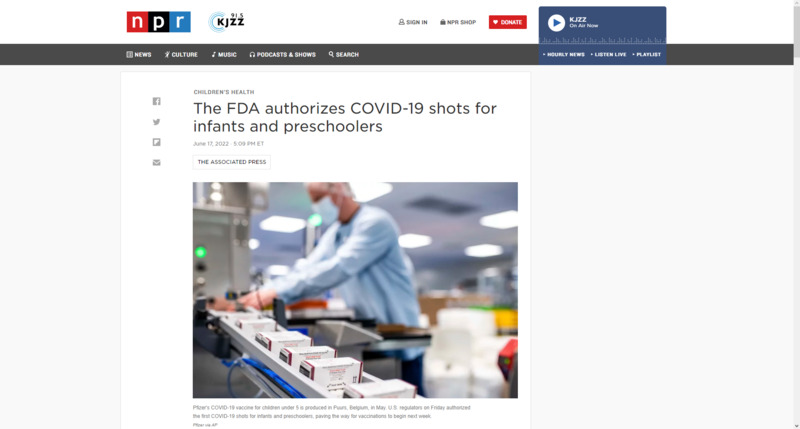 2022-06-17
2022-06-17The FDA authorizes COVID-19 shots for infants and preschoolers
This is a news story from NPR by The Associated Press. The United States has authorized the use of vaccines for infants and preschoolers. The Center for Disease Control and Prevention (CDC) is debating how the vaccines are to be administered. The article says that studies support giving these age groups the vaccines, as they are said to be effective and have minor side-effects. -
 2022-06-11
2022-06-11US will end Covid-19 testing requirement for air travelers entering the country
This is a news story from CNN by Kaitlan Collins. The CDC is expected to lift the requirement for air travelers to test negative for COVID before entering the US. The travel industry has been lobbying the CDC for months regarding this issue after it was no longer determined that the restrictions are no longer "based on the science and data." However, just because it is getting lifted now, the CDC does have the power to reinstate this restriction if a new variant develops and causes concern. -
 2022-05-03
2022-05-03CDC Tracked Millions of Phones to See If Americans Followed COVID Lockdown Orders
This is a news story from Vice by Joseph Cox. The CDC bought access to location data harvested from millions of phones in the United States. Although it was originally purchased for lockdown related reasons, it is intended to be used for non-COVID purposes too. The way they did this was through purchasing data from SafeGraph. The author of this piece mentions how the decision to do this was not without controversy, as it brings into question the freedom of movement and the rights to privacy. Google has banned SafeGraph from its app store in June. -
 2022-04-20
2022-04-20How COVID transformed trans-Pacific container shipping
This is a news story from American Shipper by Greg Miller. Due to COVID, our trade has changed. Data from Alphaliner shows how much the trade relationship between Asia and the United States has morphed. Carrier competition is up, with more players and less share from the three global alliances. In a breakdown of the data, Cosco was the trans-Pacific leader in mid-2020 as the United States was coming out of the first lockdowns. Maersk was at fourth place, carrying 30% less capacity than Cosco. In mid-2020, 2M, Ocean Alliance, and THE Alliance controlled 89% of trans-Pacific capacity. In 2021, that lowered to 82%. These alliances in 2022 now are at 67.7% of shares. -
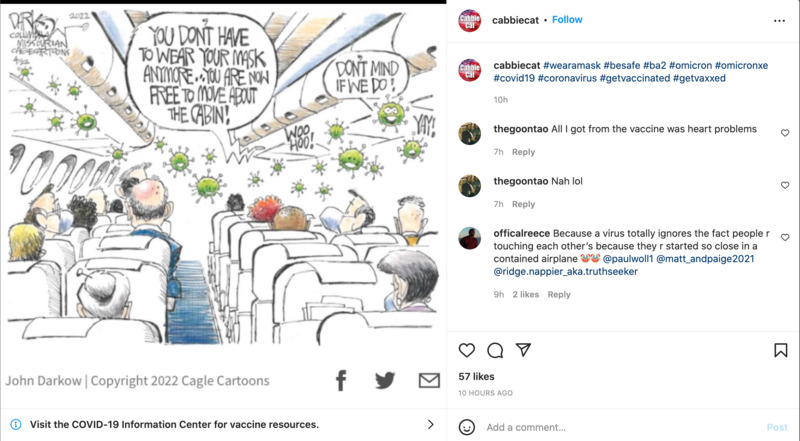 2022-04-22
2022-04-22Wear a Mask
This is an Instagram post by cabbiecat. This user posted a comic that is referencing the recent lift on plane mask mandates in the United States. The comic itself is suggesting that by people removing their masks that COVID will spread easier. -
 2022-04-07
2022-04-07Where the Government Requires Masks
This is an Instagram post by urbanpeaceinstitute. This post refers to places where mask mandates are still in existence. Even though mask mandates have been lifting in many places, certain places still want masks. Some of these places include: emergency and homeless shelters; public transit; healthcare settings; long-term care facilities; and correctional and detention facilities. These places are either government or healthcare associated. This post links to the County of Los Angeles Public Health for more information on the Coronavirus. -
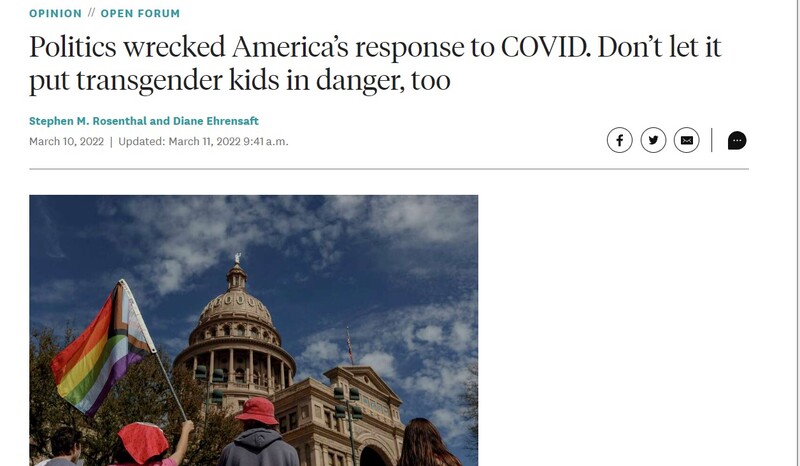 2022-03-10
2022-03-10Politics wrecked America’s response to COVID. Don’t let it put transgender kids in danger, too
This is a news story from The San Francisco Chronicle, written by Stephen M. Rosenthal and Diane Ehrensaft. This is an opinion piece comparing the government response to COVID and the politics surrounding it to ruining the response. The authors warn that following politics over science is dangerous. It later goes on to talk about the anti-trans legislation being passed through different states, such as: Idaho, Texas, and Florida. The authors believe that science proves that trans kids have no real threat from puberty blockers. A study is also quoted, where it says that gender affirming care for trans youth is linked to lower instances of depression. The point of this article is not so much about COVID itself, but fear of what was done during the peak of COVID being repeated on other types of legislation, and in this case, using politics over science with trans kids. -
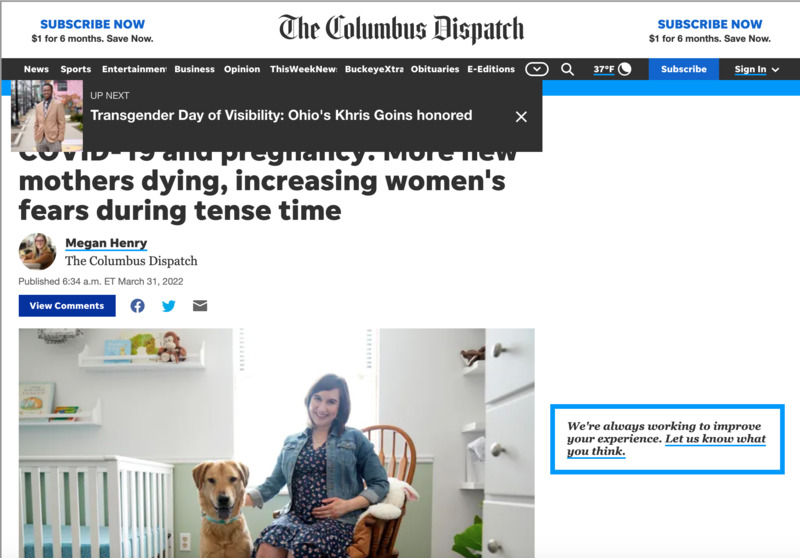 2022-03-31
2022-03-31COVID-19 and pregnancy: More new mothers dying, increasing women's fears during tense time
This is a news story from The Columbus Dispatch by Megan Henry. This story is about the rising fears of new mothers as COVID has increased their chances of dying. In 2020, motherhood mortality rate increased by 20% in the United States. There were also large disparities in who died, with Black women dying three times the rate of White women during pregnancy. Dr. Jason Melillo, an OB-GYN for OhioHealth claims that COVID is the main culprit for the rise in pregnancy related deaths. Pregnant women are more prone to complications from COVID, with things such as blood clots, stillbirth, and preeclampsia happening more often. This concern has made some couples only deciding on pregnancy until they have both been vaccinated. Dr. Melillo hopes that over time, mortality rates associated with pregnant women will go down. -
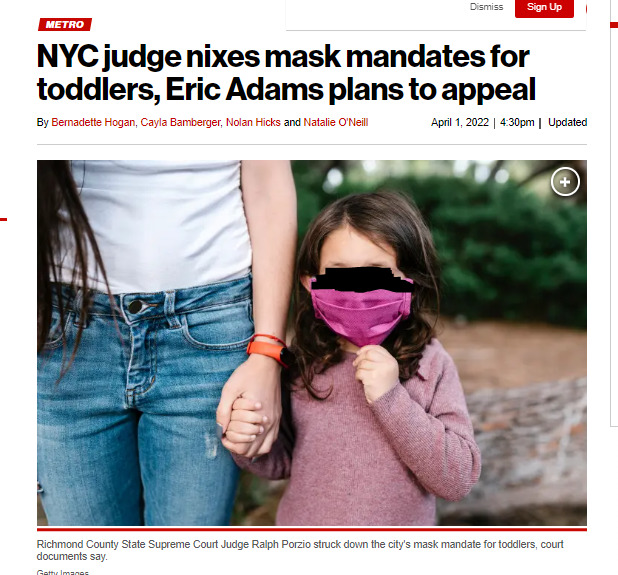 2022-04-01
2022-04-01NYC judge nixes mask mandates for toddlers, Eric Adams plans to appeal
This is a story by Bernadette Hogan, Cayla Bamberger, Nolan Hicks and Natalie O'Neill for the New York Post. This story is about masking for young kids and the struggle within the local government on what is best to do. A Staten Island judge ruled against masks for toddlers in New York City. Parents in support of this claim that this is a good thing because masks could make it harder for kids to socialize and read emotions. Eric Adams, the mayor of New York City, plans to appeal this to reinstate masks, where he believes that if you don't know the vaccination status of everyone in a room that you should wear a mask. -
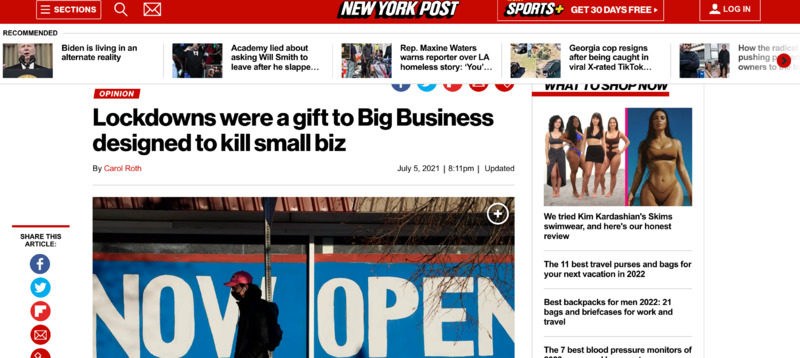 2021-07-05
2021-07-05Lockdowns Were a Gift to Big Business Designed to Kill Small Biz
This is an opinion piece by Carol Roth for the New York Post. This news story is about ways in which the lockdowns in 2020/2021 hurt small businesses, but helped big businesses. Roth claims that during the pandemic, small businesses are hitting half or less than half of their pre-lockdown revenue. Some businesses, Roth claims, possibly won’t recover at all. This article says that in 2020, the Hamilton Project accounted for 400,000 closures. I find this article to be important, as I think the business side of the pandemic needs to be told more, as these effects on small businesses impact the local and state economies, in addition to what jobs are available for people looking to go back to work after lockdowns end. -
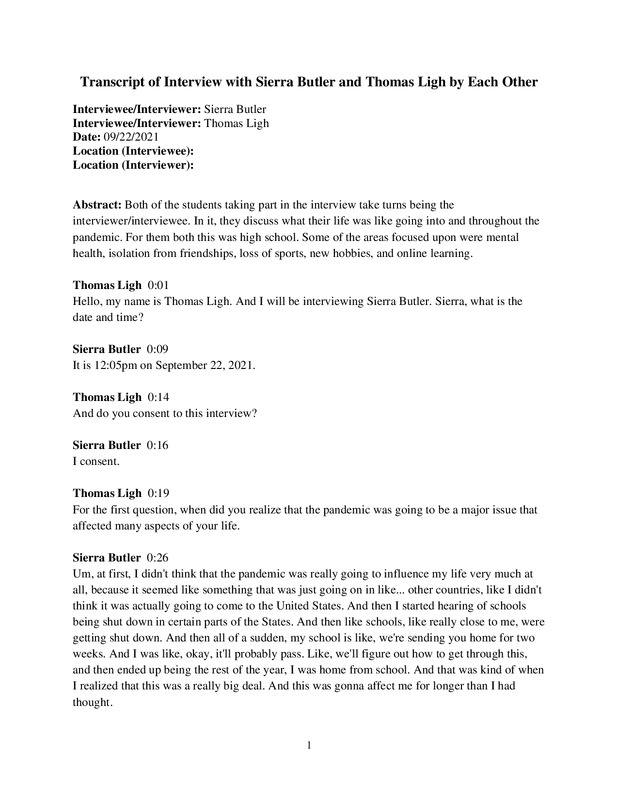 2021-09-22
2021-09-22Thomas Ligh and Sierra Butler Oral History, 2021/09/22
Interview between two first year college students who have felt the effects of COVID-19 in their every day lives, with a focus on how it has affected their learning experiences in school. -
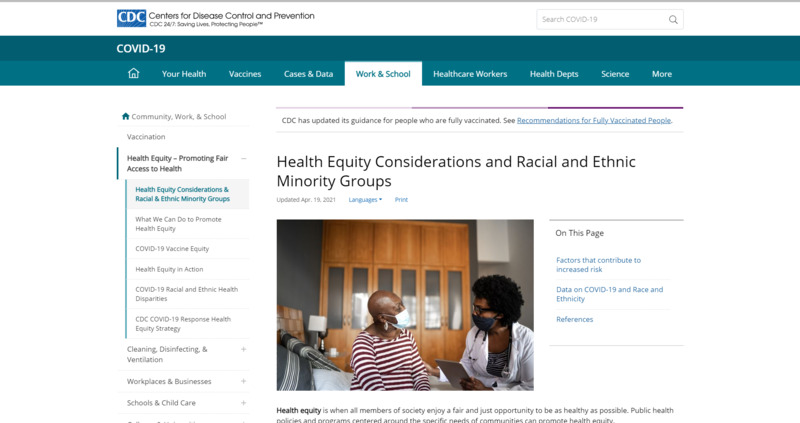 2021-04-19
2021-04-19Health Equity Considerations and Racial and Ethnic Minority Groups
The pandemic has brought the issue of health inequity in the United States, based on factors such as race and ethnicity, to the forefront. Racial and ethnic minority populations make up a disproportionate essential workers. Poverty restricts access to health care for many individuals. The country must address these issues of health equity and social justice now and continue to address it t ensure the health and safety of all those living in the United States. The website provides references, information, and data on the link between ethnicity and race and COVID-19. -
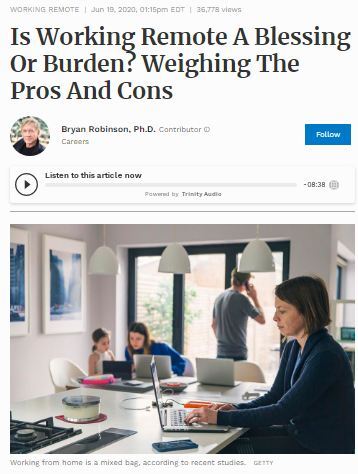 2020-06-19
2020-06-19Is Working Remote A Blessing Or Burden? Weighing The Pros And Cons
This article discusses the pros and cons of changes to productivity caused by the shift to teleworking during the pandemic in countries around the globe. Major themes are mental health and work-life balance. -
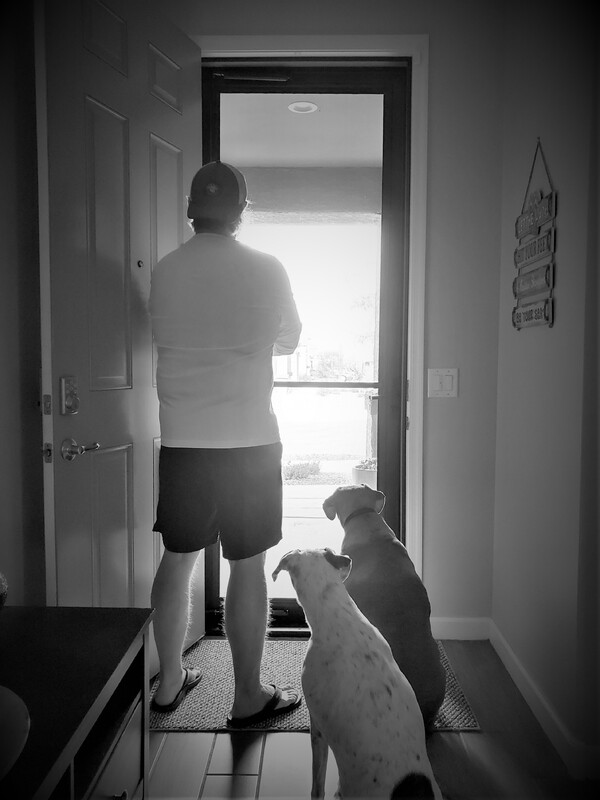 2021-04-21
2021-04-21James Rayroux's JOTPY Portfolio
--Reflections on the Pandemic Archive-- Looking back over my experience with the “Journal of the Plague Year” COVID-19 archive, my prevailing emotion is gratitude. This opportunity granted me experience that few historians earn, and the remote, asynchronous work schedule allowed me to collaborate with my colleagues in ways that maximized our respective contributions. The breadth and depth of our individual experiences and perspectives tremendously improved our collective process and products. I spent enough time in the Arizona State Archives last year to recognize such collections as historical treasure chests, but I have now participated in processing an archive’s content and navigating the ethical dilemmas those submissions sometimes create. Archivists and curators are the history profession’s truly unsung heroes, and their work facilitates society’s perception of itself. My background in police work and public safety drew me to the archive’s existing Law Enforcement collection. In taking on that subset, I succeeded in reshaping the collection’s parameters to now include stories about police and law enforcement. I wanted to diversify the collection to encompass perspective of both the police and the public with whom they interact and serve. While some overlap exists between the Law Enforcement and Social Justice collections, each remains distinct. Through my contacts and writing, I promoted a Call for Submissions to an international audience of law enforcement professionals to reduce their relative silence within the archive. Within the archive’s content, I recognized that one’s location might shape their pandemic experience, and I created and designed an Arizona-based exhibit to explore that. Further research and discussion with my mentors and colleagues ensured the exhibit illustrated these differences without excluding visitors whose diverse experiences could further enrich the archived and exhibited content. I am proud of my “Arizona’s COVID-19 Pandemics” exhibit, particularly because of its compressed, one-month incubation period. Beyond displaying images, data, and stories representative of the diverse pandemic experiences within the state, the ACP exhibit offers visitors numerous levels of interaction and engagement to became active participants and create their own exhibit experience. Visitors can complete opinion surveys, add a story to the archive, explore additional content related to the displayed pieces, view ever-changing results from pre-defined archival content searches, conduct their own archival search, view collective visitor survey results, and apply to join the staff. The exhibit’s searches will include the archive’s future submissions, which reshapes both the exhibit and the experience visitors may have with it. A more detailed explanation of my ACP exhibit may be reviewed here: https://covid-19archive.org/s/archive/item/43037 Because of Dr. Kathleen Kole de Peralta and Dr. Mark Tebeau, I stand prepared to join research, curation, and exhibition teams and immediately contribute to their work products. Despite my gratitude for this experience and the opportunities it presented, I look forward to the day COVID-19 is no longer part of humanity’s daily vernacular. James Rayroux 22 April 2021 -
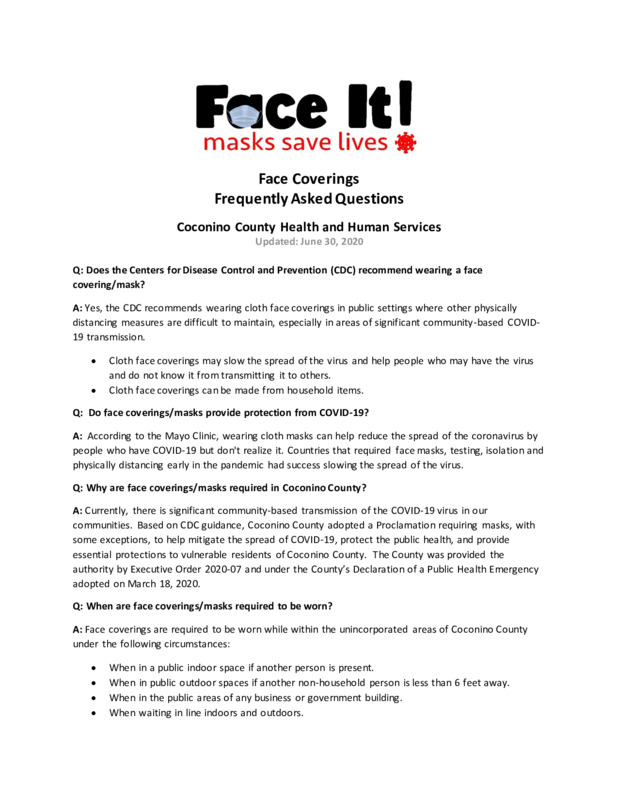 2021-04-20
2021-04-20Northern Arizona's Coconino County "Face It" Mask Campaign and Online Toolbox
The Coconino County Health & Human Services department created its "Face It" campaign in 2020 to promote the use of masks and face coverings in their communities. The following webpage is for the campaign's digital "toolbox" to give the public access to official signage for display to customers, the public, and employees to address mask use issues. -
 2021-04-19
2021-04-19Navajo Department of Health COVID-19 Case Infection Data by Region through 19 April 2021
This image, taken as a screenshot from the Navajo Department of Health website on 19 April 2021, shows COVID-19 infection case data by region within the Navajo Nation. -
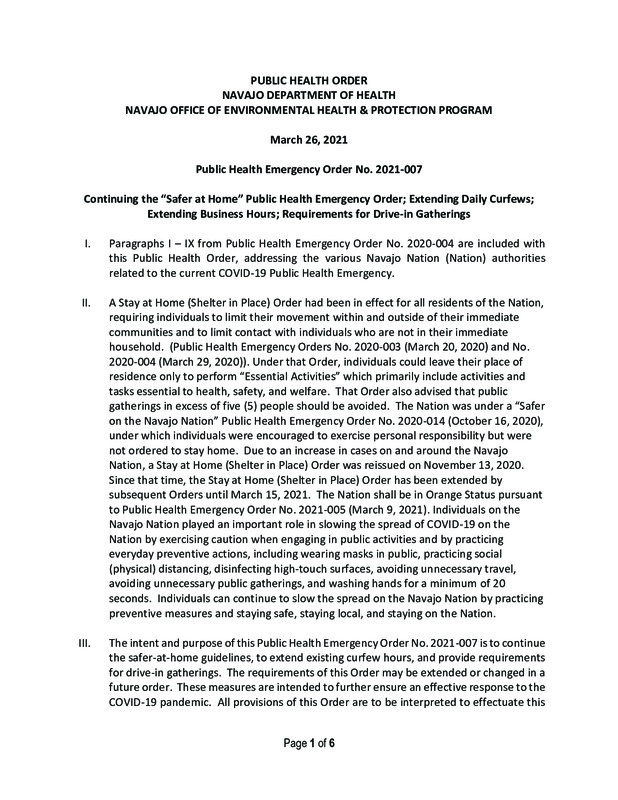 2021-04-19
2021-04-19Navajo Department of Health Public Health Emergency Orders through 19 April 2021
These eight documents are the eight Public Health Emergency Orders issued by the Navajo Department of Health issued through 19 April 2021. -
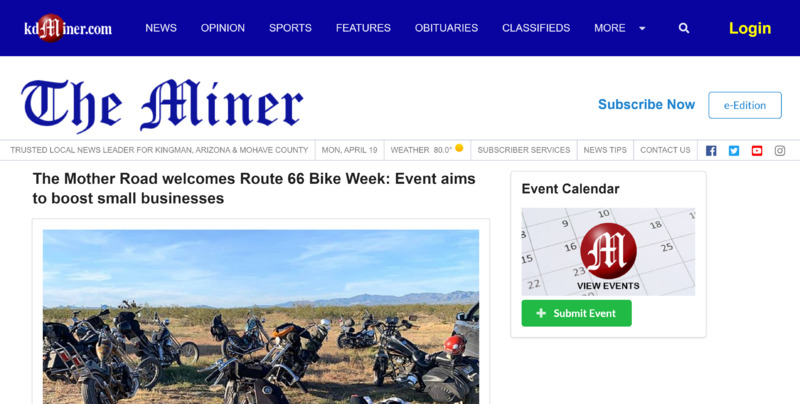 2021-04-15
2021-04-15News Article: The Mother Road welcomes Route 66 Bike Week: Event aims to boost small businesses
By Travis Rains, Kingman Daily Miner, 15 April 2021 Communities and businesses along and near the Mother Road wanted in on the action that is Route 66 Bike Week – five days of activities, games, discounts, scenic biking and more set for April 21-25 along the historic highway from Needles, California to Seligman. Event organizer Rob Borden is no stranger to motorcycle rallies as the owner of Saddle Sore Ranch, located between mile markers 36 and 37 on Route 66, approximately 17 miles from Kingman. But this is the first year for Route 66 Bike Week, which has seen the expansion of what has been dubbed the “Laughlin Loop.” “It kind of started by accident,” Borden said, noting the loop includes Route 66, going through Oatman and down over highways 95 and 68. “It’s just a nice, scenic ride for motorcycle enthusiasts. With the Laughlin River Run not happening, at least not in the past two years, I got a call from Needles, California from their tourism center asking if they could be included in this Laughlin Loop and I said ‘absolutely.’” Borden then received a call from the chamber of commerce in Oatman seeking to be included in the event. Then the City of Kingman and its visitor’s center wanted on board, followed by Seligman. “So then I’m looking at it and I’m like ‘wow, Needles to Seligman,’” Borden said. “I said ‘why don’t I just do a Route 66 Bike Week,’ and that’s how it happened. That way we can promote all these small businesses down Route 66 that even in normal times they struggle. Now with COVID, of course, they’ve been struggling even more.” So Borden began reaching out to businesses along Route 66 to see if they would be interested in participating by way of deals and discounts for event participants. “They loved the idea and wanted to be a part of it,” he said. “Basically, the idea is rather than just have a stationary event that’s confined to some big parking lot, let’s kind of highlight these businesses up and down Route 66 and get them involved. They’ve put together special offers and discounts, maybe extra effort for bands for bars. Those are different stops on the rally.” Registration for bike week can be completed by going to http://route66bikeweek.com/, with prices ranging from $45 to $48 depending on the package chosen. Borden said there is associated costs for the event that include T-shirts, bike week wristbands and dissemination of the Route 66 Passport, the latter two providing participants with access to discounts from businesses and drawings for prizes, respectively. “So when you show up with your bike week wristband, you’ll get freebies and discounts,” Borden explained. “We’ve got about 20 free drawing stops.” A scavenger hunt is planned as well utilizing the Route 66 Passport. Borden said there will be five different stops along Route 66 at which participants can have their passports stamped. Upon getting all the stamps and presenting them at Rally Central, which is Saddle Sore Ranch, they will receive a free ticket for yet another drawing. Borden also said those wishing to cruise Route 66 during bike week don’t have to register, but that they will not receive access to discounts and more. “The intent there is obviously to bring exposure to Route 66 and all these businesses, and make a big financial impact right here to the area as opposed to some of the big corporate vendors that would come into big motorcycle events,” Borden said. “When they leave, they take the money with them.” Saddle Sore Ranch will play host to biker games and activities throughout Route 66 Bike Week. Those will include poker runs, live music and popular biker contests like a big belly contest. Biker games such as slow races, barrel races, lean-your-bike and more are scheduled as well, as is a blue collar build-off judging and awards ceremony sponsored in part by Cycle Source Magazine. The build-off is a low-budget motorcycle building competition where teams from all over the country had $1,500 and 30 days to build a bike. After the sun goes down, live music will continue, vendors will open up shop and a campfire party will commence. “It’s a lot different than what people are used to with previous motorcycle rallies in the area,” Borden said of Saddle Sore Ranch. “Our venue is more reminiscent of a ‘60s or ‘70s style, easy rider rodeo kind of venue. It’s more of a traditional, old-school biker venue as opposed to the neon lights and things like that of Laughlin. It’s a completely different kind of feel and a breath of fresh air for bikers in the area to give them something to do and something different.” Route 66 Bike Week starts at 10 a.m. Wednesday, April 21 and runs until 10 p.m. Sunday, April 25. For more information on Route 66 Bike Week, go to http://route66bikeweek.com/. -
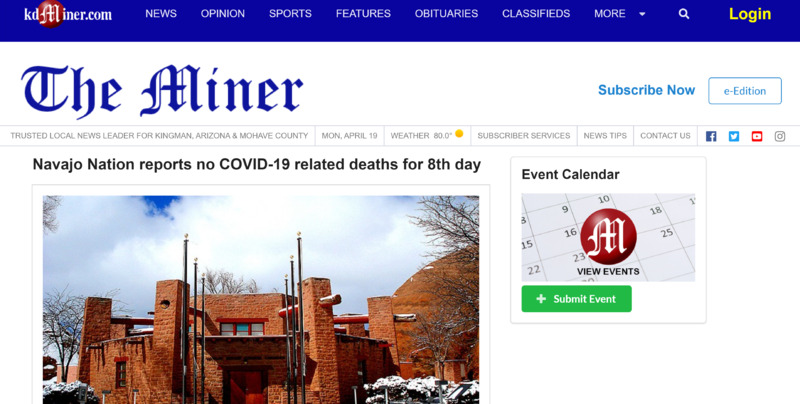 2021-04-19
2021-04-19News Article: Navajo Nation reports no COVID-19 deaths for 8th day
By Associated Press, 19 April 2021 WINDOW ROCK (AP) — The Navajo Nation is finding no new COVID-19 related deaths for an eighth consecutive day. The tribe on Sunday afternoon reported seven new virus cases but no additional deaths on the vast reservation. The latest numbers bring the Navajo Nation's pandemic case total to 30,366 with the death toll remaining at 1,262. Tribal officials said 16,477 people have recovered from COVID-19 thus far. The tribe had been easing into reopening but that slowed somewhat after coronavirus variants were confirmed on the reservation, which stretches into New Mexico, Utah and Arizona. Tribal officials urged residents to stay vigilant. Navajo President Jonathan Nez said the tribe recently had a cluster of COVID-19 cases as a result of a family gathering where people were not wearing masks. Tribal public health orders mandate that masks be worn on the reservation and a daily curfew is in effect. Restaurants cannot have dine-in services. Navajo Nation roads also are closed to visitors and tourists, which doesn’t affect travel on state highways that run through the reservation. Meanwhile, health care facilities across the reservation continue to offer the vaccine by appointment or at drive-thru events. -
 2021-04-17
2021-04-17Police clash With protesters during Adam Toledo demonstrations
Police in Chicago, Illinois, clash with protesters during demonstrations for 13-year-old Adam Toledo following the release of the police body camera footage. -
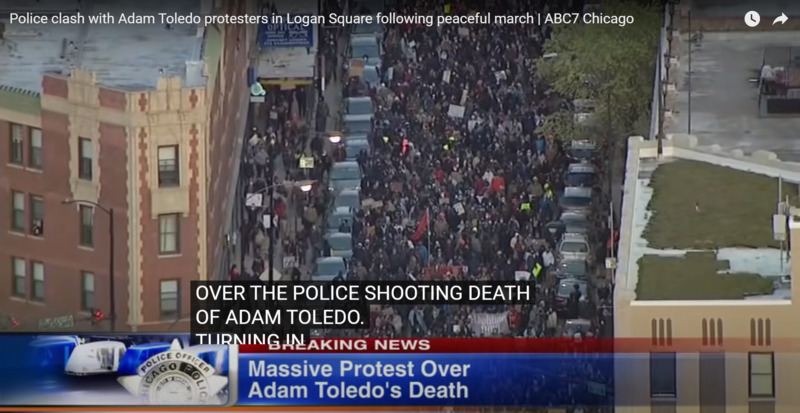 2021-04-17
2021-04-17Police clash with Adam Toledo protesters in Logan Square following peaceful march
The march was largely peaceful, but as it came to an end around 10 p.m., a small group of protesters still lingering in the streets began scuffling with police. -
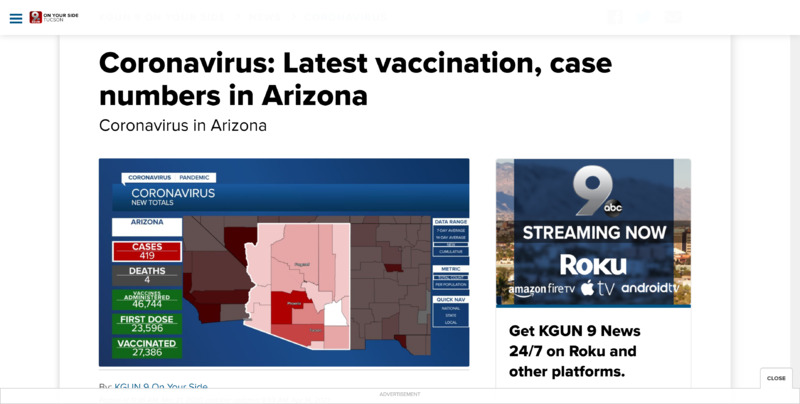 2021-04-14
2021-04-14News Article: Daily COVID-19 Updates for AZ and Counties - 04/14/2021
Coronavirus in Arizona with Emphasis on local Pima County data: By: KGUN 9 On Your Side - Posted at 11:36 AM, Mar 21, 2020 and last updated 9:03 AM, Apr 14, 2021 TUCSON, Ariz. (KGUN) — Editor's note: This article was first published on March 21, 2020. It is updated daily and refreshed with the latest updates and cases throughout Arizona. Arizona Public Health officials are tracking the spread of coronavirus throughout the state. Here are the latest numbers provided by the Arizona Department of Health Services. Last updated on April 14, 2021 FULL SECTION: CORONAVIRUS IN ARIZONA Vaccinations in Arizona: New doses reported today: 46,744 Total doses administered: 4,213,938 Total number of people who have received at least 1 dose: 2,611,983 Total number of people who have received 2 doses: 1,745,928 Percent of population vaccinated: 36.3% Vaccinations in Pima County: New doses reported today: 9,029 Total doses administered: 578,853 Total number of people who have received at least 1 dose: 363,431 Total number of people who have received 2 doses: 242,638 Percent of population vaccinated: 34.8% Cases and Deaths through 04/14/2021: Number of deaths: 17,109 Number of cases: 851,265 New cases: 419 New deaths: 4 Total number of tests reported: 8,835,798 (Diagnostic and Serology) New tests reported: 17,381 Reported cases of COVID-19 by county: Maricopa: 529,471 Pima: 113,903 Pinal: 50,417 Navajo: 16,018 Coconino: 17,398 Yavapai: 18,642 Cochise: 11,769 Graham: 5,520 Santa Cruz: 7,882 Yuma: 36,943 Apache: 11,256 Mohave: 22,353 La Paz: 2,450 Gila: 6,855 Greenlee: 568 Breakdown of cases in Pima County: Total cases: 113,903 Deaths: 2,372 New cases: 81 New deaths: -1 -
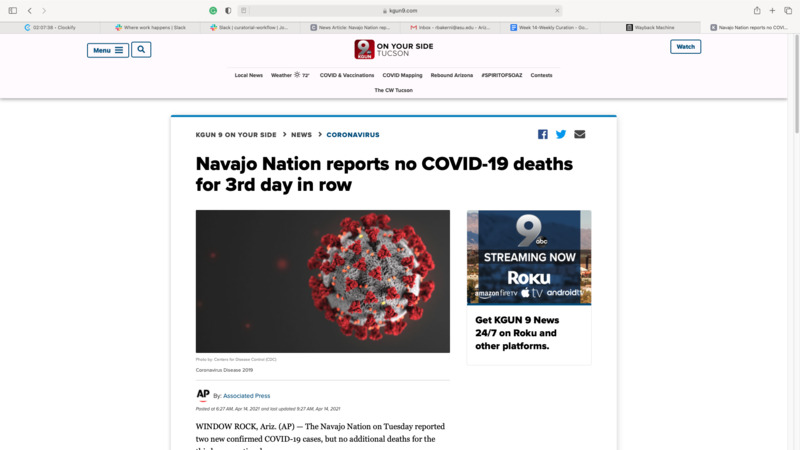 2021-04-14
2021-04-14News Article: Navajo Nation reports no COVID-19 deaths for 3rd day in row
Despite very grim months through the last year's COVID-19 pandemic in the Navajo Nation, the Associated Press reported continuing indications of success for the Navajo people and their rural communities: WINDOW ROCK, Ariz. (AP) — The Navajo Nation on Tuesday reported two new confirmed COVID-19 cases, but no additional deaths for the third consecutive day. The latest numbers brought the pandemic totals on the tribe’s reservation to 30,269 cases and 1,262 known deaths. Tribal officials had ordered a lockdown last weekend over fears that a new variant could drive another deadly surge. The Stay-At-Home order required all Navajo Nation residents to refrain from unnecessary travel to help limit the spread of the virus, including a new and more contagious strain. Navajo Nation President Jonathan Nez recently announced the first confirmed case of the COVID-19 B.1.429 variant on the reservation that covers parts of Arizona, New Mexico and Utah. -
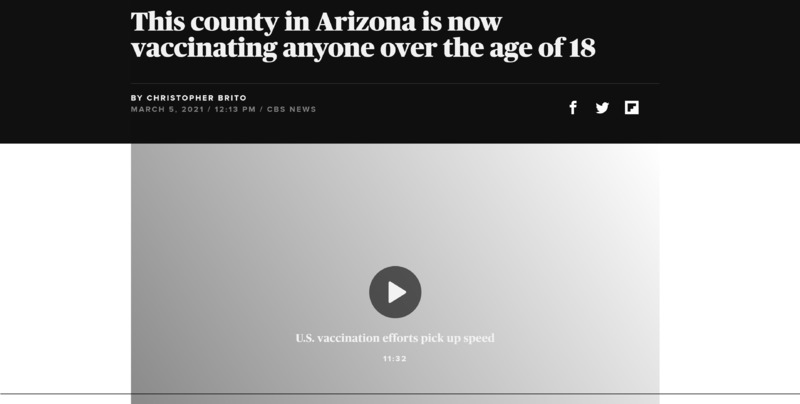 2021-03-05
2021-03-05News Article: Gila County's COVID-19 efforts lead more urban counties
"By Christopher Brito, March 5, 2021, CBSnews.com While a majority of states and cities are still vaccinating higher priority groups of people, one county in Arizona is now allowing any resident over the age of 18 to receive the COVID-19 vaccine. Gila County, which is located east of Phoenix, entered Phase 2 of their vaccine prioritization late last month, opening up eligibility to the general population. Part of the the decision to open vaccine eligibility is because Gila County has one of the lowest percentages of COVID-19 vaccine doses used in Arizona. Michael O'Driscoll, director of Public Health and Emergency Management for the county, told CBS affiliate KPHO-TV that they received permission from the state last week to offer the vaccine in a drive-thru clinic last weekend. "Prior to that, we were struggling to find enough people to make appointments to that, so the state gave me permission to offer it to any resident 18 and older," he said. About 56,000 people reside in the county. According to the Arizona's Department of Health Services, more than 13,000 people – or almost one fourth of residents – have received at least one dose of the COVID-19 vaccine. "We did a survey before to get a sense of how many people in Gila County would consider getting the vaccine, and our survey came back about 50-60% of the residents would choose to get the vaccine if available," O'Driscoll said. Based on the data, over 5,600 people under the age of 65 have received the vaccine, including 73 people under the age of 20. One of the younger recipients, 18-year-old Jacob Jost, told KPHO-TV that he was "excited" to get the shot. "I have a little nephew, a little baby, so having the vaccine puts a peace of mind for that," Jost said. First published on March 5, 2021 / 12:13 PM © 2021 CBS Interactive Inc. All Rights Reserved. Christopher Brito is a social media producer and trending writer for CBS News, focusing on sports and stories that involve issues of race and culture. -
 2021-01-27
2021-01-27More Americans Than People in Other Advanced Economies Say COVID-19 Has Strengthened Religious Faith
During difficult times, many people often turn toward religion or faith to provide hope. According to Pew Research, as a result of the pandemic, no Western country with “advanced” economies report that the pandemic has had a net negative impact on religion and faith. In fact, all have a net increase on the reliance of religion and faith. Citizens in the United States, however, are much more likely to say the pandemic has strengthened their faith as opposed to citizens in other countries. While the pandemic has had a net positive for strengthening the faith of people, it has had an even higher positive result for strengthening familial bonds. Family bonds and religious faith has grown stronger for most during the pandemic. -
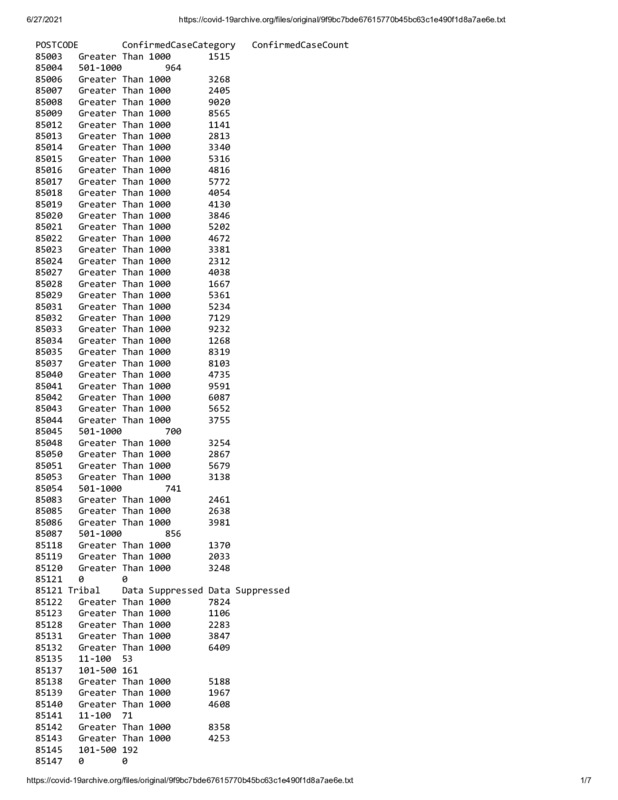 2021-04-08
2021-04-08Arizona COVID-19 Infections by Zip Code through 04/08/2021
This text file shows data from the Arizona Department of Health Services for confirmed COVID-19 infections tied to the patient's residential zip code. The data runs through 04/08/2021 and can be searched by "Ctrl + F" and entering specific zip codes. AZDHS suppressed tribal data from this data file prior to its publication on the organization's website. -
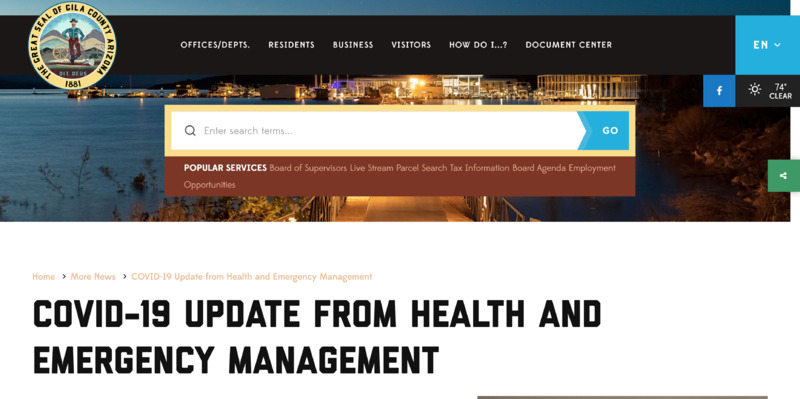 2021-04-06
2021-04-06Gila County Health Department and COVID-19
The Gila County webpage provides clear and concise information for residents on COVID-19 updates, as well as specific data to allow residents who wish to be vaccinated to choose which manufacturer's product they receive. This is unlike any of the major Arizona county sites, or even the state's site, as they do not allow residents to differentiate between the vaccines. Additionally, the information displayed here demonstrates how far ahead rural Gila County is in achieving President Joseph R. Biden's directive to allow all adults in America access to vaccines by April 19. -
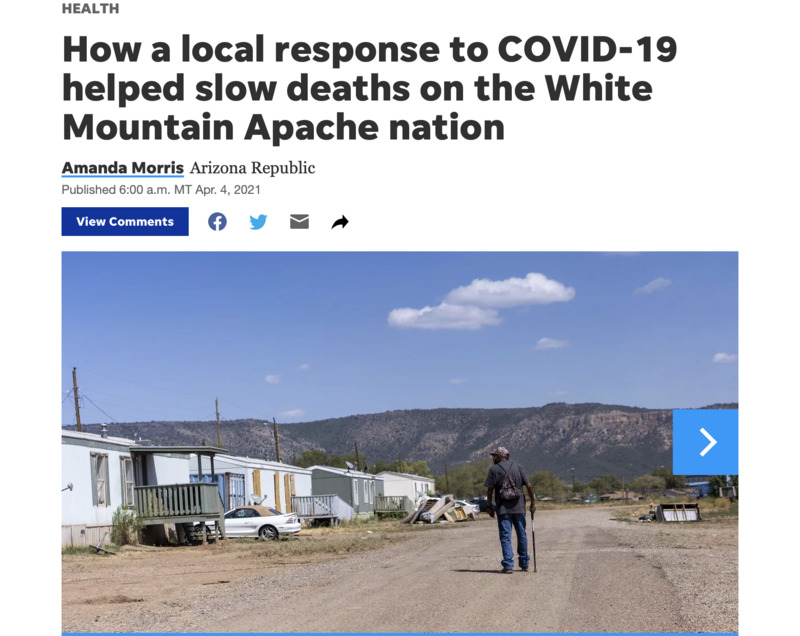 2021-04-04
2021-04-04News Article: How a local response to COVID-19 helped slow deaths on the White Mountain Apache nation
By Amanda Morris of the Arizona Republic: When someone on the Fort Apache Indian Reservation receives a confirmed diagnosis of COVID-19, health care workers from the Whiteriver Indian Hospital jump into action. They personally visit the individual's home to test other household members, perform health evaluations on everyone there and trace any other potential contacts at risk for COVID-19 exposure. Health care workers in the community say that could be one reason why, even though the rate of confirmed COVID-19 cases among White Mountain Apache tribal members is nearly triple the state's rate, the death rate is much lower and continues to fall. Over 90% of COVID-19 cases in the White Mountain community are investigated within 24 hours of testing, according to Ryan Close, the director of the Department of Preventative Medicine at the Whiteriver hospital, which is the only hospital on the 1.67 million-acre reservation. "I feel like what we did made a huge difference," Close said. "We evaluated and admitted people aggressively and early. The tribe deserves an incredible amount of credit for mobilizing staff ... to make this response possible, because at some point it would have been very difficult to maintain without their considerable help." The quick response may have also helped the tribe turn the tide against rapid community spread of the virus, which scientists say could have been fueled by a single variant found only in the White Mountain tribal communities. The variant carried a mutation in the spike protein, which scientist theorize could have made it spread more rapidly than other strains of the virus. The number of confirmed COVID-19 cases among White Mountain Apache tribal members accounts for 24% to 28% of their population, according to Close, but the cumulative death rate among known cases is only 1.2%. By comparison, the statewide rate of infection was 11.5% with a 2% death rate among known cases. And over the winter, Close said the rate for the tribe dropped even lower, to about 0.5%. In a community with a high number of individuals with underlying health conditions, the low death rate and work of the tribe has been "remarkable," said David Engelthaler, director of the Translational Genomics Research Institute's infectious disease division in Flagstaff. The death rate also stands out as unusually low when compared with death rates in other Indigenous communities. Indigenous populations have been disproportionally affected by the pandemic. CDC data shows that Indigenous people are 3.5 more likely to be diagnosed with COVID-19 and almost twice as likely to die from COVID-19 than white people. Close credits a proactive strategy to combat COVID-19 that involved rapid contact tracing, in-person health evaluations and frequent outreach to high-risk COVID-19-positive individuals as well as early treatment with monoclonal antibodies and other antiviral therapies. Volunteers and health workers from the White Mountain Apache community were on the Whiteriver hospital's contact tracing team and high-risk COVID-19 outreach team, which Close said helped the team connect better with the people and work faster. One essential part of the team are the tribe's community health representatives, or CHRs, who are members of the community that serve as a cultural bridge between patients and medical establishments. JT Nashio, director of the Community Health Representatives for the tribe, said the "visceral connection" that CHRs have to the community helps them bring cultural awareness to the way questions are asked for contact tracing, which makes the process more effective and allows officials to better distribute information. "On top of that, quite simply, they know how to get around. It’s a big reservation and not all homes are easy to find," Nashio said. "But when you’ve lived here your whole life, you know where to find people. That became invaluable during the tracing and testing push during case surges." Virus mutation may have made it more transmissible When COVID-19 hit the White Mountain Apache nation, it spread rapidly. The community's first documented case was on April 1, 2020, from someone who had likely recently visited the Phoenix area, unknowingly caught COVID-19 and returned, according to Engelthaler. Within the first few weeks, Close said the community experienced a handful of deaths. "We soon had incidence rates that were skyrocketing. Case counts were going up very, very quickly," Close said. It's unclear why the disease spread so rapidly in the community, but the initial strain of COVID-19 that hit the community carried a mutation that Engelthaler believes could have made it more transmissible. "They were seeing the virus just rip through and have an 80 to 90 to 100 percent attack rate," he said. TGen partnered with the tribe and the U.S. Indian Health Services early on to provide tests to diagnose a case of COVID-19 and provide genetic analysis of the virus from each case. It showed one strain of the virus circulating in the tribal community that wasn't present anywhere else in the state. "This virus moved much faster than anything else we were seeing in Arizona at the time," Engelthaler said. "So we actually believe that we had one of these variant strains in Arizona that was causing very large numbers of cases, but it was secluded and maintained really only in that tribal population." The mutation, called the H245Y mutation, occurred in the spike of the virus, which Englethaler said is a "very sensitive" part of the virus where mutations can have a significant impact. Because of the low death rate, Engelthaler said TGen researchers would like to investigate the mutated strain of coronavirus seen among tribal members to see if it is also associated with a lower fatality rate. He acknowledged that other strains of the virus have since entered the community and that the actions of health care workers in the community and at the Whiteriver hospital is also responsible for the lower death rates. 'The earlier you treat an illness, the better' Close's biggest concern was that an outbreak would cause a "tsunami" of sick COVID-19 patients that would run the risk of overwhelming the Whiteriver hospital, which does not have an intensive care unit. Any patients that require intensive care need to be transported to other hospitals in the state. "We're a small hospital, we cannot take a wave of all very acute patients because there aren't enough ventilators in the hospital," Close said. "There aren't enough helicopters in the state to transport people out from our facility to a higher level of care." Within the first few weeks, Close said the community experienced a handful of deaths, and patients who had the poorest outcomes were the ones who self-presented at the hospital — often meaning they waited until they felt sick enough to go to the hospital. "People don't always bring themselves in early enough," Close said. "The earlier you treat an illness, the better." In response to this phenomenon, the hospital started a high-risk outreach program the third week of April. Health care workers regularly visited the homes of anyone who tested positive for COVID-19 and was at high risk for a poor outcome. Close recalls multiple days when he evaluated patients and found their oxygen levels dangerously low, even though they felt fine. It's a condition associated with COVID-19 known as "silent hypoxia," or "happy hypoxia." "They had no sense that they were even ill. They went on to get pretty sick in the hospital, but they survived and you can't help but think to yourself, 'Yeah, that's a life saved,'" Close said. "That person, if they had stayed home another day or another two days would not have done as well. They would have ended up on a ventilator or something." The Arizona Republic previously reported that the effects of the high-risk outreach program and contact tracing led to a fatality rate among tribal members of 1.6% last June, which was less than the state's rate of 2.5% and country's at 2.7% at the time. But the effect of the outreach program became even more pronounced over the winter, as the tribe and health workers gained access to monoclonal antibody treatments, according to Close. He said the high-risk outreach team started referring patients for antibody treatment in December as part of their protocol after the therapy received emergency use approval from the Food and Drug Administration. Hospital staff at the Whiteriver hospital then administered the antibody treatment. "We give that to people who are asymptomatic or mildly ill to prevent hospitalization," Close said. "The evidence currently suggests that reduces the risk that they're going to get sicker and get hospitalized and reduces the risk that they're going to die." Though there's no data proving the antibody treatments made a difference, Close said that after health care workers started using them, the community's COVID-19 death rate fell to 0.5%. Hospital workers also gave antiviral therapies, such as remdesivir, to patients early and often. "We probably overtreated some people," he said. "But the good news is it definitely led to significant reductions in mortality." Lessons for the future Close believes the different programs were so successful because health care workers were often able to test, trace, diagnose and treat individuals all in the same day — a feat he said was only possible because of how closely integrated hospital workers and community health workers were. "There were no barriers in communication between the public health arm of our response and the clinical care arm of our response," Close said. "It's really a case for an integrated health care system." As the tribe emerges from the pandemic and tribal members get vaccinated against the virus, Close said the hospital may start exploring other health conditions where it can use the high-risk outreach team, which is already trained and experienced in clinical evaluations. "The goal is to take what we've learned from COVID and now apply it to things that are not COVID-related," Close said. Another valuable lesson Close hopes to carry forward is how much of a difference visiting residents in their homes can make and how important building trusting relationships with the community is. Nashio said going door to door to trace and monitor COVID-19 cases was a natural step for CHRs, who had already gone door to door in the past for other community health campaigns. "We know firsthand how difficult it can be to not only connect with patients over the phone but communicate effectively over the phone," Nashio said. "When the community sees their CHRs coming to their door, it helps decrease the stigma of the disease." In addition to performing checkup evaluations and providing information, Nashio said CHRs can also provide food, medical supplies, cleaning supplies or services like grocery shopping and running basic errands. Not every tribal member has reliable internet or phone service, nor access to transportation, so Close said going door to door can be a good way to reach, and help, everyone. "Meeting patients where they are is invaluable," Close said. Amanda Morris covers all things bioscience, which includes health care, technology, new research and the environment. Send her tips, story ideas, or dog memes at amorris@gannett.com and follow her on Twitter @amandamomorris for the latest bioscience updates. Independent coverage of bioscience in Arizona is supported by a grant from the Flinn Foundation. -
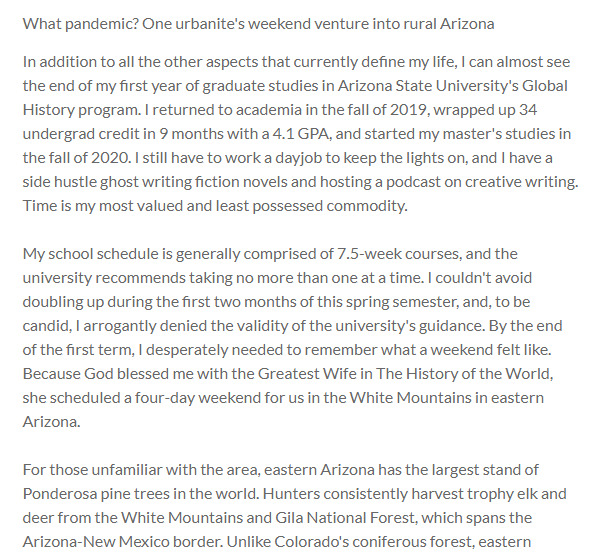 2021-03-04
2021-03-04What pandemic? One urbanite's weekend venture into rural Arizona
In addition to all the other aspects that currently define my life, I can almost see the end of my first year of graduate studies in Arizona State University's Global History program. I returned to academia in the fall of 2019, wrapped up 34 undergrad credit in 9 months with a 4.1 GPA, and started my master's studies in the fall of 2020. I still have to work a dayjob to keep the lights on, and I have a side hustle ghost writing fiction novels and hosting a podcast on creative writing. Time is my most valued and least possessed commodity. My school schedule is generally comprised of 7.5-week courses, and the university recommends taking no more than one at a time. I couldn't avoid doubling up during the first two months of this spring semester, and, to be candid, I arrogantly denied the validity of the university's guidance. By the end of the first term, I desperately needed to remember what a weekend felt like. Because God blessed me with the Greatest Wife in The History of the World, she scheduled a four-day weekend for us in the White Mountains in eastern Arizona. For those unfamiliar with the area, eastern Arizona has the largest stand of Ponderosa pine trees in the world. Hunters consistently harvest trophy elk and deer from the White Mountains and Gila National Forest, which spans the Arizona-New Mexico border. Unlike Colorado's coniferous forest, eastern Arizona seems devoid of pine beetle kill. Nothing but healthy, evergreen forest and the scent of sun-warmed pine greets you. We stayed in a vacation home on the outskirts of Pinetop, brought our groceries from home, and largely intended on hiking, cooking, drinking, and doing a lot of nothing. When we arrived in Pinetop in early March 2021, I had already fully recovered from COVID-19 and had time for both of my Moderna vaccines to have taken full effect. My wife had neither protective barrier, but we had generally become comfortable with purpose-driven shopping (as opposed to "window shopping") and takeout dining. As such, we stopped into a bakery to get breakfast on the way out to the hiking trails as a vacation treat. To our surprise, many of the patrons weren't wearing masks while walking through the restaurant or waiting in line. That made us a little uncomfortable. Then, one of the employees walked out from the kitchen with no mask on and began working on filling orders at the front, cold-food storage counters. Both of us panicked a bit and considered cancelling our orders and leaving. My wife pulled up the Arizona Department of Health Services site and quickly found that entire county had endured only a little more than 560 cases. A quick bit of division translated that into an average of two infections per day for the entire pandemic year-to-date. The statistical odds of the unmasked clerk or patrons presenting a health risk to either of us fell to just north of zero. NOT zero, but we both felt we could see it from there. The ham, egg, and cheese croissants were delicious, by the way. In trying to be good guests, we continued to wear our masks whenever we ventured into public spaces and businesses. Less than half of those around did the same, and I didn't see or hear anyone confront each other about mask wearing. Our last venture out that weekend was to a beer garden with a prominent outdoor patio and seating area. We again wore our masks inside the establishment, but we immediately felt like outcasts for having done so. When we stepped inside, it looked as though the town villain had just stepped through the saloon doors: all activity inside the business stopped, and everyone seated inside turned around to look us up-and-down for few silent moments. If anyone had been playing piano, they would have switched to a minor key. NO ONE else inside wore a mask, and the interior tables didn't appear to have been spaced to comply with prevailing social distancing guidelines. Everyone stayed kind of quiet until we ordered beers and asked to sit outside. In hindsight, I wonder if they expected we were there from some government bureaucracy to issue citations, or just out-of-towners about to have a value-based hissy fit? I have been generally opposed to broad behavior mandates that typically justify compliance on urban problems, but that weekend compelled me to really consider the divergent pandemic realities Arizonans have endured for the past year. Further analysis of county-specific data seems to suggest at least four divergent pandemic experiences within Arizona: urban centers, border counties, rural counties, and Native American reservations. I hope to better understand the personal experiences of those who lived in these diverse regions and how the pandemic affected their perspective and reality. -
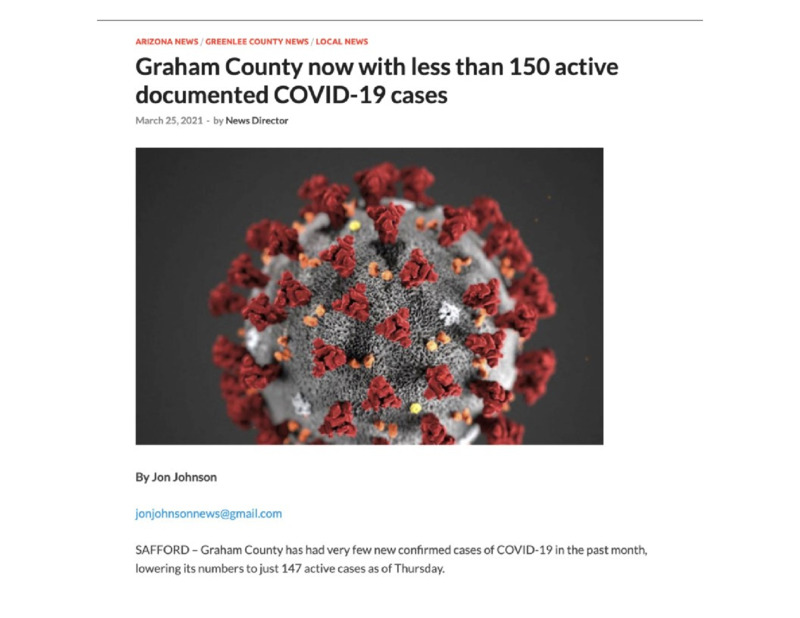 2021-03-25
2021-03-25News Article: Graham County (AZ) now with less than 150 active documented COVID-19 cases
"By Jon Johnson, jonjohnsonnews@gmail.com SAFFORD – Graham County has had very few new confirmed cases of COVID-19 in the past month, lowering its numbers to just 147 active cases as of Thursday. According to the Graham County Department of Health and Human Services, Graham County has had a total of 5,355 confirmed cases for the course of the pandemic, with 5,132 listed as being recovered, 147 active, and 76 deaths in more than a year. No new cases were recorded Thursday, and, according to the Arizona Department of Health Services COVID-19 school dashboard, Graham County had just a 1 percent positivity rate as of the week of March 14. That is good for a tie with Apache County for the second-lowest percent positivity rate out of Arizona’s 15 counties. Only Greenlee County, which registered a zero percent positivity rate from Feb. 27 – March 14, had lower. With the lower cases statewide and vaccine rollout, Governor Doug Ducey issued an Executive Order on Thursday, rolling back several COVID-19 mitigation measures involving businesses and gatherings. This comes as other states roll back their COVID-19 mitigation measures as well. The rollout of the various COVID-19 vaccines has picked up steam in the last month, with the state opening up the vaccine to anyone 16 years old or older for the Pfizer vaccine. Anyone 18 years old or older can be administered the Moderna and Johnson & Johnson vaccines. The San Carlos Apache Healthcare Corporation is holding a free, drive-through vaccine clinic on Saturday, March 27 at the San Carlos High School. No appointment is necessary. The clinic will be administering both the Pfizer and Moderna vaccines. Graham County and Greenlee County are also providing vaccination sites for those 18 and older, and provide the Moderna and Johnson & Johnson vaccines. Greenlee County: According to the Greenlee County Health Department, the county currently has just nine active cases of COVID-19. For the course of the pandemic, Greenlee County has had 568 confirmed positive cases (by far the lowest out of any of Arizona’s 15 counties), with 549 recovered cases, nine active, and 10 deaths." -
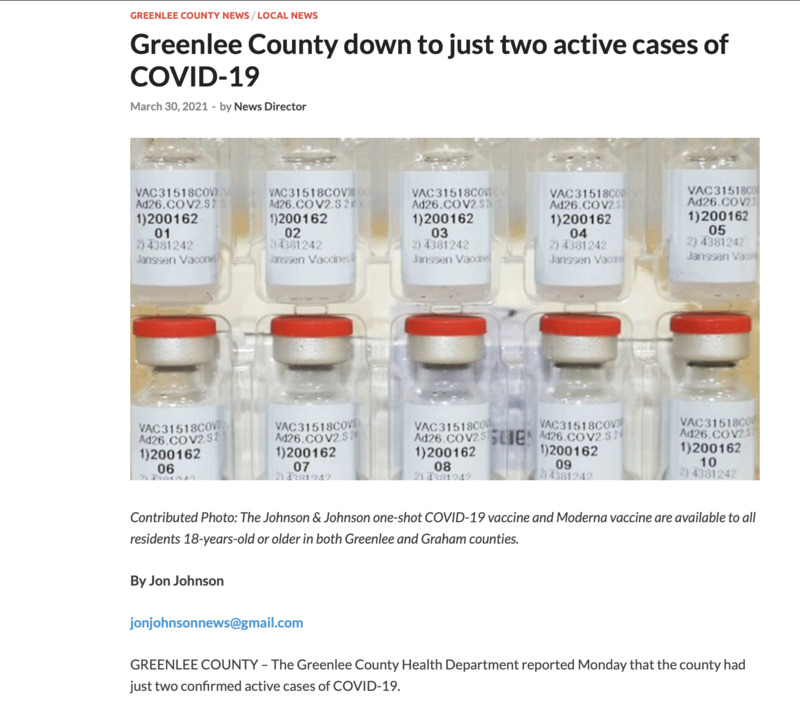 2021-03-30
2021-03-30News Article: Greenlee County (AZ) down to just 2 active COVID-19 cases
"By Jon Johnson, jonjohnsonnews@gmail.com GREENLEE COUNTY – The Greenlee County Health Department reported Monday that the county had just two confirmed active cases of COVID-19. Greenlee County has tested more than 5,000 people for the course of the pandemic and has had a total of 568 cases, with 556 recovered and 10 deaths. The county offers the Moderna COVID-19 vaccine to all residents 18-years-old or older, and on Thursday (01-April-2021) Gila Health Resources will have a vaccine clinic for the one-shot Johnson and Johnson COVID-19 vaccine. Click here to learn more or to register. According to the Arizona Department of Health Services, 37.5 percent of Greenlee County’s residents have been vaccinated for COVID-19. That is the highest percentage out of Arizona’s 15 counties. Conversely, Graham County is listed as having just 18.1 percent of its population vaccinated, which is the third-worst out of Arizona’s counties behind Maricopa County at 17.5 percent and Apache County at 10.7 percent. Graham County: The Graham County Department of Health and Human Services reported three new confirmed positive tests for COVID-19 on Tuesday. While Graham County has had 5,364 total confirmed cases of COVID-19, as of Tuesday the county had just 138 confirmed active cases. Out of all its confirmed cases, 5,150 are listed as being recovered, and 76 have died. Graham County is also offering both the Moderna and Johnson & Johnson vaccines to all residents 18-years-old or older. Click here for more information." -
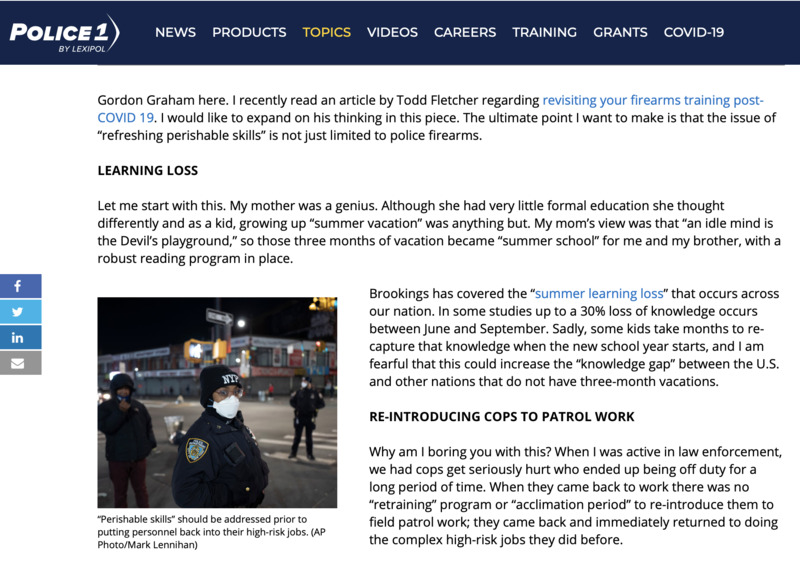 2021-03-10
2021-03-10Op/Ed: How to get officers back up to speed in a post-COVID world
In this article, retired California Highway Patrol Lieutenant, attorney, and professional risk manager Gordon Graham discusses the factors police agencies should be considering and planning for as we hope to soon begin transitioning to a post-COVID/post-pandemic world. Among these are traditional and analogous considerations agencies have long dealt with, such as the return of employees from extended military assignments or recovery from injuries. Many of the finely honed skills that helped keep officers and the public safe prior to February 2020 will have eroded from a lack of use, and it will be incumbent upon agencies and officers alike to undertake these returns to normalcy with serious and deliberate caution. -
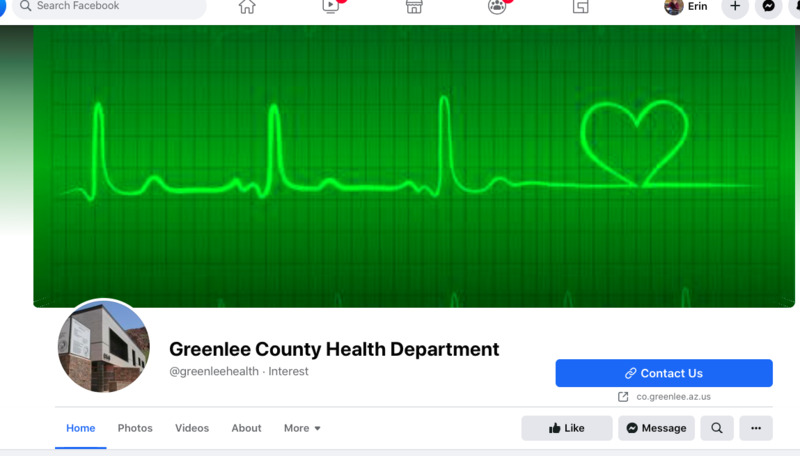 2021-04-05
2021-04-05Greenlee County (AZ) Health Department's Daily COVID-19 Updates through April 5, 2021
The Greenlee County Health Department uses its Facebook page to disseminate daily information related to the COVID-19 pandemic to its residents. The daily COVID-19 statistics are displayed as an image on the daily Facebook post, which allows examination of the department's content and messaging before and after the pandemic. Governor Doug Ducey declared a state of emergency in Arizona on March 11, 2020, which seems inconsistent with GCHD's daily posts from that period. Language on the GCHD posts consistently advised residents to stay home if they felt ill, rather than being consistent with Governor Ducey's voluntary Stay Home orders. For example, the March 30, 2021, press release to update a new active COVID-19 infection in Greenlee County reads as follows: "For Immediate Release, Tuesday, March 30, 2021, Greenlee County, Arizona. Public Information Contact: Steve Rutherford (928) 865-2601 NEW RELEASE - COVID-19 Positive Test in Greenlee County The Greenlee County Health Department is investigating one (1) new confirmed case of COVID-19. The case will put our current total at five hundred and sixty-nine (569) confirmed Greenlee County COVID-19 cases... We would like to remind the community to use masks appropriately when outside of the home, practice social distancing, wash your hands frequently, and do not go into the public when you are feeling sick, unless you are seeking medical attention." These updates demonstrate a significant dichotomy between the rural and urban experiences during this pandemic. -
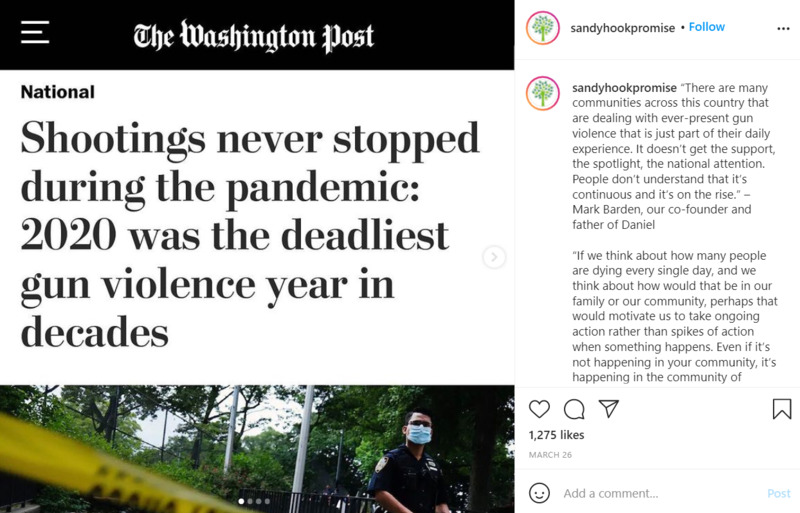 2021-03-26
2021-03-262020 Was a Record Year for Gun Violence
“There are many communities across this country that are dealing with ever-present gun violence that is just part of their daily experience. It doesn’t get the support, the spotlight, the national attention. People don’t understand that it’s continuous and it’s on the rise.” – Mark Barden, our co-founder and father of Daniel “If we think about how many people are dying every single day, and we think about how would that be in our family or our community, perhaps that would motivate us to take ongoing action rather than spikes of action when something happens. Even if it’s not happening in your community, it’s happening in the community of America.” – Nicole Hockley, our co-founder and mother of Dylan Swipe left. Read more in @washingtonpost. Click the link in our bio to take action to #EndGunViolence. #ProtectOurKids #PassUBC #PassBGC #SHPAction #SandyHookPromise -
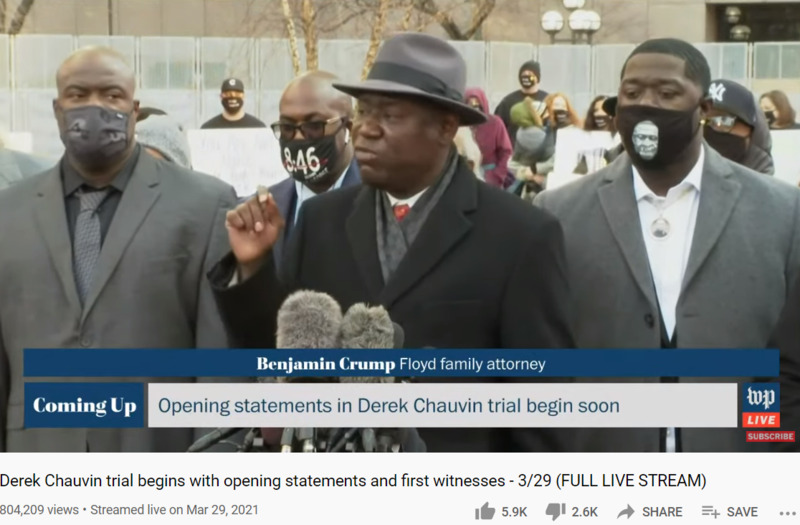 2021-03-29
2021-03-29Derek Chauvin trial begins
Derek Chauvin, the former Minneapolis police officer filmed with his knee on George Floyd’s neck in May, faces murder and manslaughter charges for the encounter that sparked months of historic protests around the world. This stream contains graphic content. Chauvin faces charges of second- and third-degree murder and second-degree manslaughter. Three other officers charged in the case — J. Alexander Kueng, Thomas K. Lane and Tou Thao — are set to be tried separately in August. George Floyd died on May 25 after being handcuffed and restrained facedown on a Minneapolis street during a police investigation of a counterfeit $20 bill that allegedly had been passed at a local market. The Post’s Rhonda Colvin will anchor live coverage featuring reporters Holly Bailey and Joyce Koh from Minneapolis. The program will also feature reporters Keith Alexander, Mark Berman, Tim Craig, Nicole Ellis, Hannah Jewell and Eugene Scott -
 2021-03-30
2021-03-30A Tale of Two Arizonas: COVID-19 Data from Maricopa and Greenlee Counties Through March 30, 2021
This daily tracker displayed on the New York Times site displays and explains public data provided by the Arizona Department of Health Services. The attached graphs illustrate the disparate COVID-19 experience between Arizona residents in Maricopa County and Greenlee County. Arizona is the sixth largest of the United States with a population of more than seven million residents within its 113,594.08 square miles. 61% of Arizonans reside in Maricopa County, which translates to a population density of approximately 481.3 people per square mile, or 57,959.3 square feet per resident. In contrast, southeastern Arizona’s Greenlee County claims only 0.14% of the state’s residents for a population density of 5.7, or approximately 4.8M square feet per person. -
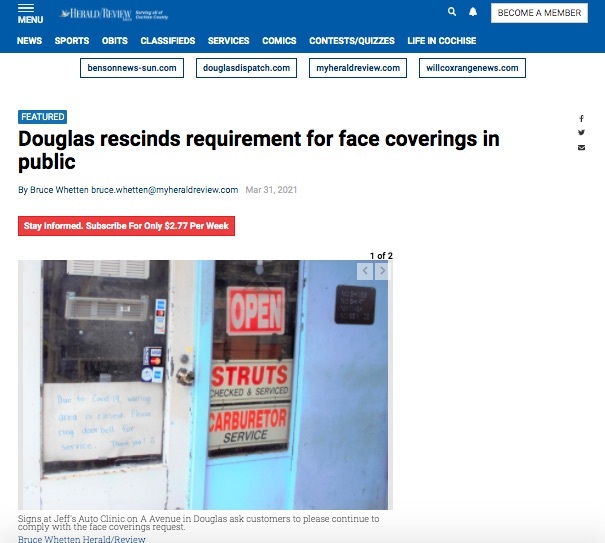 2021-03-31
2021-03-31News Article: Douglas rescinds requirement for face coverings in public
This news story relays a decision by municipal leadership in Douglas, Arizona, to rescind their mask mandates following Governor Ducey's similar order on 25-March-2021. -
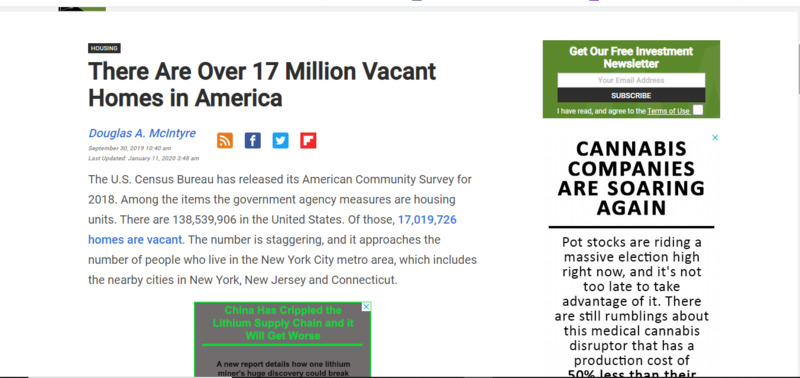 2019
2019Homeless and Homes
This article reports that they are over 17 million empty homes in the United States which greatly outnumbers the amount of homeless people in the country. The article then goes on to describe the location and other demographics of where these homes are. I wanted to include this article because it shows that we have the resources for people to not be homeless during the pandemic but there seems to be no incentive or interest in addressing this problem. The number of homes is so much greater and it could greatly mitigate some of the health and exposure issues homeless populations experience. This will allow me to show how homeless people are traditionally not even considered in resources. -
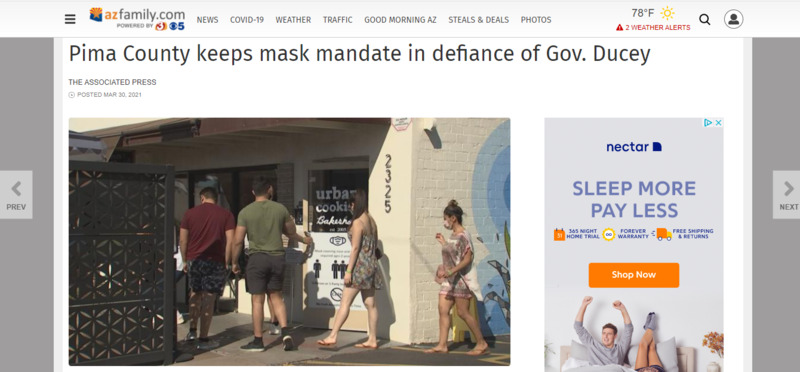 2021-03-30
2021-03-30News Article: Pima County keeps mask mandate in defiance of Gov. Ducey
This article from the Associated Press relays the arguments Pima County officials have made in keeping mask mandates in place despite recent orders from Governor Doug Ducey on 25-March-2021 that prohibit new mask requirements and phase out current restrictions previously issued by local governments across Arizona. -
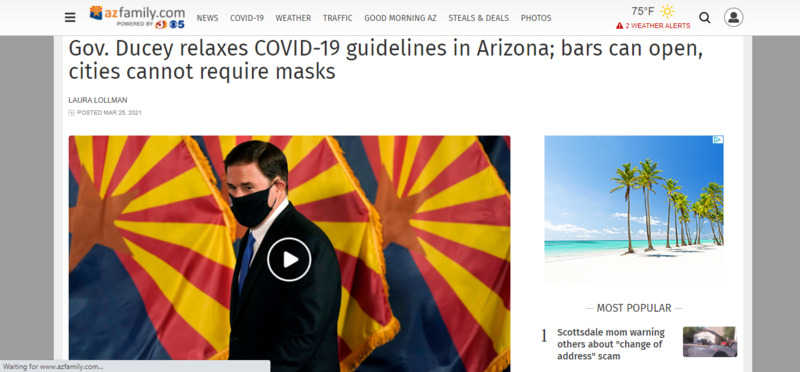 2021-03-25
2021-03-25News Article: Gov. Ducey relaxes COVID-19 guidelines in Arizona; bars can open, cities cannot require masks
This news article from Laura Lollman of 3TV/CBS5 in Phoenix, Arizona, relays updated COVID-19 guidelines that Gov. Doug Ducey signed into place on March 25, 2021. These included a statewide phase-out of municipal and county mask mandates and prohibitions on new mask mandates; businesses may continue to require patrons and employees to use masks or face coverings; gatherings of more than 50 people no longer require permission from local governments; bars may fully open and choose to require patrons and employees to wear masks and social distance -
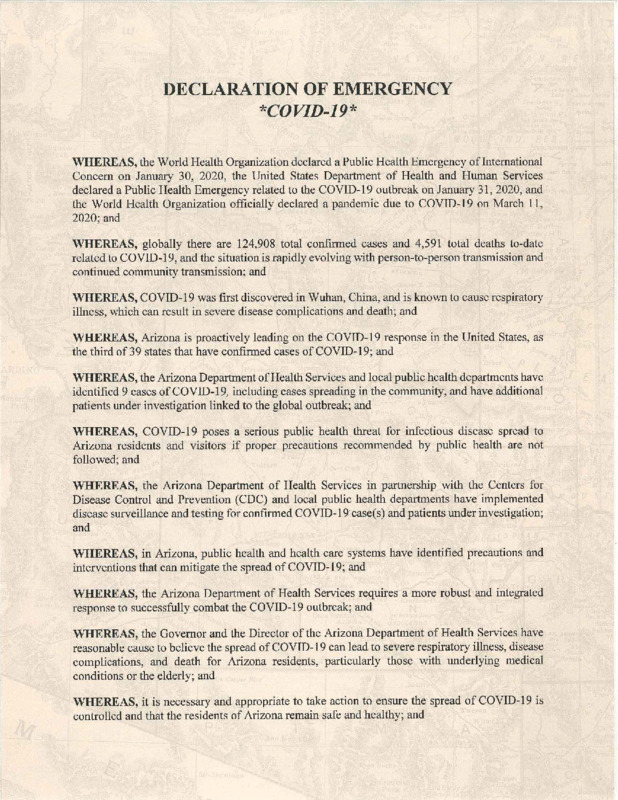 2020-03-11
2020-03-11March 11, 2020: Arizona Declaration of Emergency by Gov Doug Ducey
Declaration of Emergency - COVID-19 WHEREAS, the World Health Organization declared a Public Health Emergency of International Concern on January 30, 2020, the United States Department of Health and Human Services declared a Public Health Emergency related to the COVID-19 outbreak on January 31, 2020, and the World Health Organization officially declared a pandemic due to COVID-19 on March 11, 2020; and WHEREAS, globally there are 124,908 total confirmed cases and 4,591 total deaths to-date related to COVID-19, and the situation is rapidly evolving with person-to-person transmission and continued community transmission; and WHEREAS, COVID-19 was first discovered in Wuhan, China, and is known to cause respiratory illness, which can result in severe disease complications and death; and WHEREAS, Arizona is proactively leading on the COVID-19 response in the United States, as the third of 39 states that have confirmed cases of COVID-19; and WHEREAS, the Arizona Department of Health Services and local public health departments have identified 9 cases of CO VID-19, including cases spreading in the community, and have additional patients under investigation linked to the global outbreak; and WHEREAS, COVID-19 poses a serious public health threat for infectious disease spread to Arizona residents and visitors if proper precautions recommended by public health are not followed; and WHEREAS, the Arizona Department of Health Services in partnership with the Centers for Disease Control and Prevention (CDC) and local public health departments have implemented disease surveillance and testing for confirmed COVID-19 case(s) and patients under investigation; and WHEREAS, in Arizona, public health and health care systems have identified precautions and interventions that can mitigate the spread of COVID-19; and WHEREAS, the Arizona Department of Health Services requires a more robust and integrated response to successfully combat the COVID-19 outbreak; and WHEREAS, the Governor and the Director of the Arizona Department of Health Services have reasonable cause to believe the spread of COVID-19 can lead to severe respiratory illness, disease complications, and death for Arizona residents, particularly those with underlying medical conditions or the elderly; and WHEREAS, it is necessary and appropriate to take action to ensure the spread of COVID-19 is controlled and that the residents of Arizona remain safe and healthy; and WHEREAS, the Governor is authorized to declare an emergency pursuant to A.R.S. § 26-303(D) and in accordance with A.R.S. § 26-301(15). WHEREAS, pursuant to A.R.S. § 26-307(A), a state agency, when designated by the Governor, may make, amend and rescind orders, rules and regulations necessary for emergency functions; WHEREAS, pursuant to A.R.S. § 36-787(A), during a state of emergency declared by the Governor as a result of an occurrence or imminent threat of illness or health condition caused by an epidemic that poses a substantial risk of a significant number of human fatalities or incidents of permanent or long-term disability, the Arizona Department of Health Services shall coordinate all matters pertaining to the public health emergency response of the State; and WHEREAS, pursuant to A.R.S. § 36-787(B) and (C), during a state of emergency declared by the Governor, the Governor, in consultation with the Director of the Arizona Department of Health Services, may issue orders pertaining to the public health emergency response of the State; and WHEREAS, pursuant A.R.S. § § 36-788 and 36-789, during a state of emergency declared by the Governor, the Arizona Department of Health Services, to protect the public health, may establish and maintain places of isolation and quarantine and require the isolation or quarantine of any person who has contracted or been exposed to a highly contagious and fatal disease; WHEREAS, the Legislature has authorized the expenditure of funds in an event of an emergency pursuant to A.R.S. § 35-192; and WHEREAS, Executive Order 2017-06 establishes the Arizona Emergency Response and Recovery Plan to assist in responding to emergencies including public health emergencies; and NOW, THEREFORE I, Douglas A. Ducey, Governor of the State of Arizona, by virtue of the authority vested in me by the Constitution and Laws of the State, do hereby determine that the COVID-19 outbreak presents conditions in Arizona, which are or are likely to be beyond the control of the services, personnel, equipment, and facilities of any single county, city or town, and which require the combined efforts of the State and the political subdivision, and thus justifies a declaration of a State of Emergency; accordingly, pursuant to A.R.S. §§ 26-303(0) and 36-787, I do hereby: a. Declare that a State of Emergency exists in Arizona due to the COVID-19 outbreak, effective March 11, 2020; and b. Direct that the State of Arizona Emergency Response and Recovery Plan be used, and the Division of Emergency Management to be engaged, as necessary or requested, to assist the Arizona Department of Health Services' coordination of the public health emergency response and authorize the use of state assets as necessary; and c. Authorize the Director of the Arizona Department of Health Services to coordinate all matters pertaining to the public health emergency response of the State in accordance with A.R.S. Title 36, Chapter 6, Article 9; This Emergency Declaration will be eligible for termination upon the resolution of the outbreak as determined by the Arizona Department of Health Services. IN WITNESS WHEREOF, I have hereunto set my hand and caused to be affixed the Great Seal. of the State of Arizona. ATTEST: GOVERNOR (Douglas Ducey) DONE at the Capitol in Phoenix on this 11th day of March in the Year Two Thousand Twenty and of the Independence of the United States of America the Year Two Hundred and Forty-Fourth. ATTEST: Secretary of State (Katie Hobbs) -
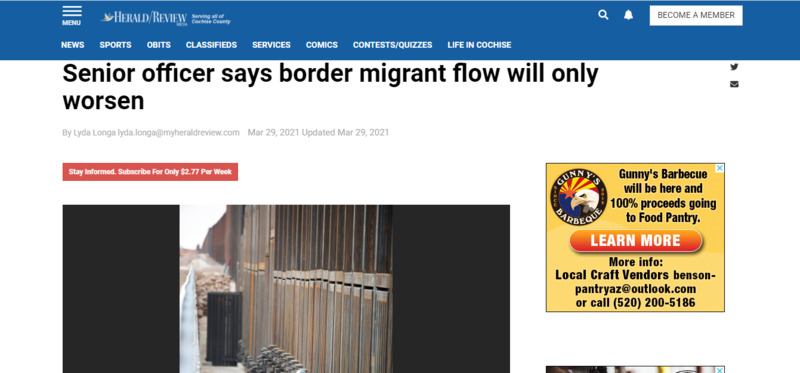 2021-03-29
2021-03-29Senior Border Patrol officer says border migrant flow will only worsen
"Senior officer says border migrant flow will only worsen" By Lyda Longa, lyda.longa@myheraldreview.com, Mar 29, 2021 The situation with undocumented migrants flocking to the Southwest border of the United States from Mexico is only going to worsen, a senior Border Patrol agent warned Friday. The agent, who spoke to various media outlets during a conference call, said at least 380,000 undocumented people had been apprehended at the Southwest border in February and the numbers would be higher for March and beyond. The agent spoke on background with the agreement that media would not reveal his name. “I fully expect to see the numbers increase as we go into the summer months,” the senior agent said, concerning migrant crossings. In Cochise County that warning has begun to bear out near Douglas and in Willcox, where the already stretched-thin Border Patrol is arresting more single adults attempting to slip into the country or taking in and processing children who are flocking to the border unaccompanied. Douglas Mayor Donald Huish said Friday the latest information he received this week from Border Patrol agents at the station just outside Douglas is that they’re confronting and repatriating about 100 single adults daily who are trying to slip in illegally. “They are getting closer and closer to town,” Huish said. What concerns Huish even more is that Border Patrol agents from the Douglas station are being pulled out to help in busier areas such as Yuma and Tucson. “They’re siphoning them off to the western part of the state and leaving us with a skeleton crew,” Huish said. In Willcox, Mayor Mike Laws said he was told two weeks ago by the Border Patrol there were 54 unaccompanied children at the Border Patrol station. “That was two weeks go. Who knows now?” Laws said. “The station can only hold up to 81.” Laws said he was told by Border Patrol that a “third party” has been arriving at the facility and taking 10 to 20 children to Phoenix by via bus. The mayor said he does not know how often the transportation comes or who the third party is. “We have not seen anyone (undocumented migrants) running the streets so far,” Laws said. “All we have is the youths, but we don’t see them either.” Laws and Sierra Vista Mayor Rick Mueller said citizens in their respective communities would gladly help the undocumented migrants but there aren’t enough resources available to do so. Laws, Mueller and other mayors in Cochise County signed a letter recently asking the federal government for help with the matter. Last week, the town of Gila Bend, which has a population of about 2,000, declared an emergency after Border Patrol agents dropped off a group of migrant families with children in a park. Gila Bend Mayor Chris Riggs told reporters he and his wife ended up using loaned vans to drive the families to the Phoenix Welcome Center so they would have a safe place to stay. Riggs said Border Patrol agents told him to expect more of the same. Mueller said there have been no such issues in Sierra Vista, but he is worried that the municipality, if hit with something similar to what happened in Gila Bend, would have no resources to offer. Last week Arizona senators Kyrsten Synema and Mark Kelly announced they’ve been pushing for more federal resources to help Arizona cities with a sudden influx of undocumented migrants. The senators helped secure at least $110 million from the Federal Emergency Management Agency as reimbursement to cities that assist migrants left within their jurisdictions. Also last week, Arizona Gov. Doug Ducey and Florida Senator Rick Scott — who sits on the Homeland Security Committee — called on President Joe Biden and Department of Homeland Security Secretary Alejandro Mayorkas to visit the Southwest border. Ducey and Scott, accompanied by a handful of law enforcement and other elected officials, had toured a portion of the border near Douglas. At his first press conference on Thursday since taking office in January, Biden said he would come to the border soon, but thought a visit now would deflect attention from the issue at hand. The senior Border Patrol agent who spoke Friday, meanwhile, said 300 Border Patrol agents who work along the northern border of the U.S. have been “mandated” to the Southwest border to assist with the influx of migrants. He said about 2,000 family units out of the 6,000 who are trying to cross daily are being processed in Texas by the Border Patrol. The agent revealed that unaccompanied children are being kept in Border Patrol facilities longer than the 72 hours established by law because too many are showing up and agents are overwhelmed. “They’re keeping them a few days, sometimes up to a week,” the senior agent said. Once an unaccompanied child is encountered, Border Patrol contacts the Department of Health and Human Services. The latter makes arrangements for the migrant children to be taken by the Office of Refugee Resettlement. The agent also mentioned an increase in the criminal element among undocumented migrants. “The threats we see are significant,” the senior agent said. “We have seen criminal (undocumented migrants).” Additionally, he said that COVID testing for migrants is only being done in facilities in Del Rio, Texas, and soon in the Rio Grande Valley in Texas. Other than that, testing is being undertaken by non-governmental agencies that are helping the migrants and U.S. Immigrations and Customs Enforcement officials. He said it was probable that some migrants with COVID-19 may have been released into communities. -
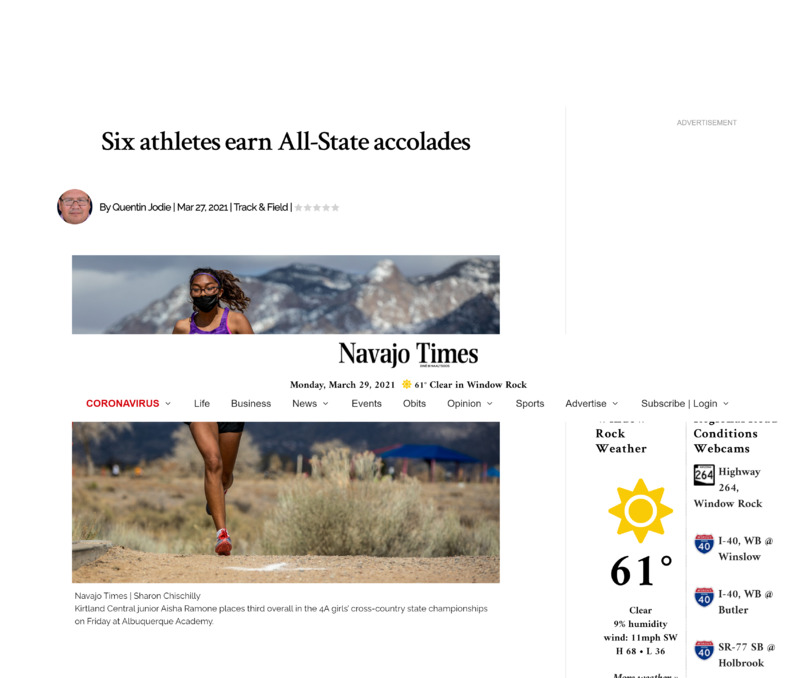 2021-03-27
2021-03-27Running Masked Up: Six Navajo Nation Athletes Earn All-State Accolades
By Quentin Jodie | Mar 27, 2021 | Track & Field | Navajo Times | Sharon Chischilly Kirtland Central junior Aisha Ramone places third overall in the 4A girls’ cross-country state championships on Friday at Albuquerque Academy. ALBUQUERQUE It’s been a long time coming for the Tohatchi boys’ cross-country team. On Friday, the Cougars placed four runners in the top 20 at the New Mexico Class 3A state cross-country meet as they secured the second-place trophy. “It’s been a while since we took one of these home,” Tohatchi coach Fern Spencer said of the red trophy. The longtime coach is not sure when was the last time they brought home a state trophy in cross-country but she said it was well deserved. “It’s very good for the program,” she said when asked if the state runner-up trophy is a nice addition to the trophy case. “They’re all young so we have another year with them. We’re going to continue to work hard and keep improving.” The Cougars were not the only school to take home hardware as six athletes earned All-State honors. In the 4A girls’ race, Kirtland Central’s Aisha Ramone and Shiprock’s Kaydence Platero placed third and fourth, respectively. “Finishing in the top three was my main goal and I got it,” Ramone said, who finished the 5K race in 19:47.77. “I just felt like I could have stayed up with the Albuquerque Academy runner (Emma Patton) but I just didn’t dig deep down enough to finish second.” Nonetheless, the KC runner was happy that she improved from last season’s sixth place finish at state. Platero was another runner who saw improvements from last year as she jumped four spots to fourth this year. “I’m so happy that I made the top five,” Platero said. “This is a big morale boost for me because I didn’t have a lot of confidence in myself but my team, my coach and the whole town of Shiprock cheered me on.” Platero, who was clocked in at 20:00.26, said her game plan worked to near perfection as she tried to shadow Ramone. “I tried to hang with Aisha and I tried to execute that but they did take off,” she said. “But in the end I was still able to finish behind them.” With a team score of 83 points, the Aztec Lady Tigers placed fourth while Shiprock took fifth with 94 points. In the 4A boys, Miyamura’s Tayan Benson made the podium with a 10th place finish. “I was hoping to do better than last year, but I just couldn’t do that today,” the Miyamura junior said. In the team standings, the Shiprock Chieftains placed fourth while Miyamura took sixth. In the 3A boys’ race, Albuquerque Cottonwood Classical ran away with the state title with 14 points while the Cougars finished with 47 points. Tohatchi was led by Nicolas Yazzie as he placed 10th overall. “It means a lot to us,” Yazzie said. “We all come in every day to practice and we give it our all. It just led to this moment and I think the time and effort we put into this paid off. I couldn’t have done it without them.” In addition to Yazzie, the Cougars had Melvin Scott Jr. place 14th, Jimmie Chavez III 17th and Jared Peterson 20th to complete the team score. Tohatchi’s fifth runner, Rodney Joe placed 30th overall. Individually, Crownpoint’s Tylon Tsosie and Newcomb’s Damien Johnson were named to the 3A All-State team by placing in the top 10. Tsosie took seventh, one spot ahead of Johnson. In the 1A/2A meet, the Ramah girls and Rehoboth boys took fifth in their respective races. -
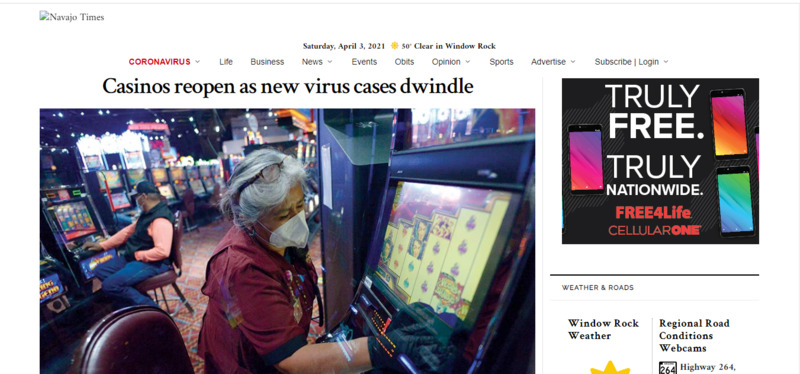 2021-03-25
2021-03-25Navajo Nation casinos reopen as new virus cases dwindle
By Donovan Quintero | Mar 25, 2021 | Business, CORONAVIRUS | CHURCH ROCK, N.M. Peterson Zah has a concern. On Tuesday, while hundreds of Fire Rock Casino patrons tried to win some money, the former Navajo Nation president wanted to hear what the COVID-19 public service announcement sounded like in Navajo. “I didn’t hear any of the PSA while inside because it’s so noisy,” he said. After taking a step outside the casino, the former Navajo Nation president said he was able to hear it. But that raised a concern for him. “And it’s pretty good,” Zah said, explaining the PSA in Navajo was clear and concise. “But you can only hear that clear outside and inside you can’t really understand it.” Zah said he was concerned no one would hear the COVID-19 safety guidelines everyone needed to follow. His other concern was that since many Navajo people have gotten both doses of the vaccines, many of them might become emboldened. “The reason why I was concerned is people have this attitude that because of the shots … they say, ‘Hey, I’m immune, I don’t have to worry about the virus.’ So when I go places I’m gonna take mine (mask) off,”’ Zah said Tuesday. According to the president’s office, more than 76,000 people have been fully vaccinated as of March 23 and more than 191,000 total doses have been administered. Zah didn’t think people should take any chances by easing up on protecting themselves from the contagious respiratory virus because some people were not wearing masks. After being closed for more than a year, Fire Rock Casino and Northern Edge Casino were on the fifth day of a two-week “soft reopening.” Just the gambling portion of the casinos were open at 25% capacity, and only Navajo Nation residents were allowed into the casinos, according to Navajo Gaming interim CEO Brian D. Parrish. Parrish clarified Navajo Nation residents meant everyone, including non-Natives, living on the reservation would have access to the casinos during the reopening phase. “We’re doing it with a two-phase reopening plan that started with Fire Rock and Northern Edge first,” he said. “We’re going to reevaluate with the Navajo Nation. They’re going to do audits and monitor our implementation of our workplace safety plan.” Of the 1,180 casino employees, 650 have returned to work since last Friday, said Parrish. Employees like Fire Rock Casino housekeeper Mildred Russell, who said she’s been out of work for over a year, were happy to be working again. “It’s been a struggle,” Russell said while cleaning a slot machine last Friday. “Hopefully this pandemic will be gone and everybody can go back to their normal lives.” Other employees, like casino security officer Vernon Keeswood from Hogback, New Mexico, shared Russell’s gratitude for getting the call to go back to work. “It’s good,” he said on Tuesday during a telephone interview that was arranged by Michele J. Crank, executive director of communications and public relations for Navajo Nation Gaming Enterprise. Instead of the usual hugs and shaking hands, Keeswood said, now it was “fist bumps” and “elbow bumps.” As for the reopening, he said many Northern Edge Casino customers “are pleased and happy” the Navajo casinos have begun reopening. He added a few customers were not sure if the casinos should reopen. “I hope everyone washes their hands and practices social distancing so we open to 100 percent capacity,” Keeswood said. “I hope it opens more.” After all, the threat of another COVID-19 outbreak looms on everyone’s mind, including that of Robert Peterson from Thoreau. “People are still afraid to come here but a lot of them want to enjoy being out instead of being stuck at home,” said Peterson, who said he lives alone, last Friday. Peterson said being alone and dealing with the pandemic has been hard for him. Despite his fears, he decided to head to Fire Rock to get his mind off COVID-19. Mary E. Silversmith, 79, from Lupton, Arizona, ensured no one came to visit her with a “no visitors allowed” sign posted on her hogan. She was happy to support the casino employees who returned to work. “The casinos were opened for the casino employees,” she said on Tuesday at Fire Rock. “Many of have children and they have bills to pay. “Because of that, I am OK with the reopening,” she said. “Some people have been criticizing the reopening. Not me, I don’t think that way or talk that way.” Before the pandemic, Silversmith said she frequently ate at Fire Rock, as well as at Twin Arrows Casino and Resort, when she had extra money to spend. Silversmith was wearing a surgical mask. To gain entry into both casinos during the soft reopening, a state ID, like a driver’s license, is required and a working number at which customers can be contacted. Temperature checks were also part of the requirements for anyone wanting to enter. After their temperature was checked, security asked customers to momentarily remove their masks and look at the front entrance security camera. The purpose of collecting all of the information is for contact tracing, said Parrish. “We have an excellent plan that’s in place,” he said. “We’ve had it reviewed and modified and enhanced by public health experts, not only on Navajo, but outside the Navajo Nation.” He added that Navajo Gaming invested close to $2 million in “equipment, supplies, signage, training,” to keep everybody safe. U.S. Indian Health Service officials toured both of the casinos’ kitchens on March 12, Parrish added, to review their safety procedures. “And in terms of reopening of the other properties, especially at a higher capacity percentage, that’s going to be based not only on how well the enterprise does, but what’s happening with the public health metrics, the rate of vaccinations on Navajo and other key indicators like that,” the interim CEO said. The Navajo Gaming enterprise’s careful planning even got praise from Jordan Schermerhorn, a senior research associate at Georgetown Center for Global Health Science and Security. Schermerhorn stated in an email to NNGE their plan showed the tribe was leading “the entire country in a smart, careful return to normalcy.” “Combined with the Navajo Nation’s outstanding vaccine rollout, this soft reopening shows what is possible with a data-driven pandemic response in a community dedicated to public safety,” Schermerhorn‘s email said. Even the ventilation, air conditioning and heating systems, which completely re-circulate the air inside the casinos 15 times a day, were reviewed, said Parrish. “We’re ready to go to fifty percent, we’re ready to offer food and we’re ready to bring the rest of our team back,” Parrish said. Zah watched casino patrons trying to win money as sounds from the Tuesday afternoon hustle and bustle all but drowned out the COVID-19 PSA. “So basically, the attitude shouldn’t be such now that because they got their shot they don’t have to worry about it,” he said. “It’s still around. Even though ninety percent of the people may be wearing their mask, or all of them, if one of them comes in that has it, then we’re in trouble.” Zah explained a new COVID-19 variant is much smaller than the original strain, which to him was why everyone needed to double mask. “If you can see light through your mask that means it’s gonna go through,” Zah said. “We gotta start wearing two masks.” He said he intends to go on KTNN and remind everyone not to run off to Phoenix or Albuquerque just because they’ve been vaccinated. “At the same time, they still have to follow those protocols,” he said. “I want to say, ‘You gotta start wearing double masks.’” As of Tuesday night, the Navajo Nation Department of Health reported a cumulative 30,010 cases of the virus and 1,233 deaths. -
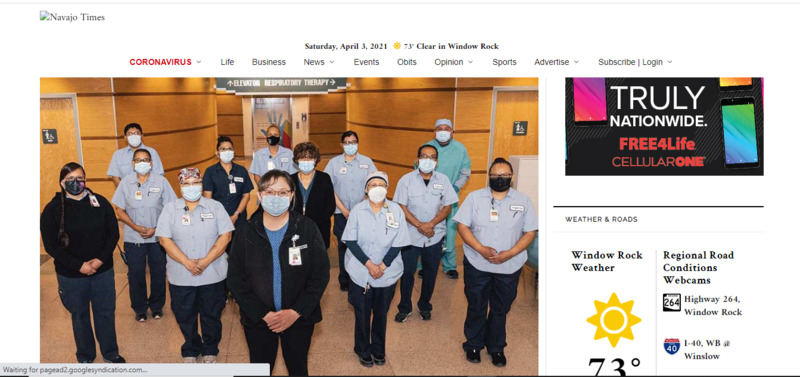 2021-03-26
2021-03-26‘They became warriors’: Reflections from the front lines as Tséhootsooí Medical Center workers share experiences
By Rima Krisst | Mar 26, 2021 | CORONAVIRUS, People | Tséhootsooí Medical Center workers share experiences Wilberta “Billy” Jackson, public health nurse III This pandemic has been the longest roller coaster of stress, grief, and loss. I’ve kept my routine simple – sleep, eat, and exercise. And, more sleep. This has been and will probably be the most challenging time of our lives. I could focus on all the bad, but so much good has come from this, from community members stepping up, leaders rolling their sleeves up and getting dirty, how we came together to care for our elders, and so much more. Professionally, we’ve adjusted and readjusted a million times over and completely changed how we deliver health care. We’ve had information, guidance, and policies being added or changing every day and we still were able to deliver health care in a safe, efficient manner. At the beginning of the pandemic, our leaders were warning everyone about the health care system being overwhelmed. Most people thought about it in terms of hospitals running out of beds, but they didn’t think of it in terms of how an underfunded and shorthanded public health force would respond to a pandemic in a rural area with limited resources, and where a population’s most basic physiological and safety needs are not being met. When you don’t have access to clean water, food, shelter and security, you’re not able to prioritize prevention measures until your basic human needs are addressed. The resiliency of the Diné people is unrivaled. The days I’m struggling or feel like giving up, I hear my grandmother’s words, and that’s what keeps me going. And my mother’s surprise delivery of Navajo soul food meals. I’m a public health nurse, so it won’t come as a surprise that I’m excited about the COVID vaccines. We’ve already seen a substantial decline in cases, hospitalizations, and deaths, so we know it’s working. My hope is that our response to the next pandemic or health care crisis won’t be complicated by politics, lack of national strategy, lack of preparation, and misinformation. Stacey Burnside, Primary Care registered nurse What I have learned from this pandemic is to cherish every day and every person that you love. COVID-19 has impacted my family and me profoundly. I lost an uncle and an aunt to COVID-19, and to this day, it is surreal that they are gone. As a primary care nurse, it is difficult to hear about losing a patient to COVID-19, and at the peak, it was almost a daily occurrence… The challenges that I faced during this pandemic were adapting to the changes in work roles and being separated from the people I love. The clinic that I worked in was closed when the pandemic hit the first peak, and I, along with my coworkers, was informed that we had to work in the Emergency Room. The moment that I saw a patient who needed me to be their nurse, despite having COVID-19, humbled me. That moment in the ER humanized COVID-19 for me and made me realize that I was put there for a reason. No matter what the situation is, nurses adapt, and the teamwork and strength we draw upon each other are phenomenal. A huge hit to me personally and professionally was losing a friend to suicide … dealing with grief, loss, and stress has been a daily thing. What has helped me is drawing strength from my God, husband and son, and family. There are many negatives to the pandemic, but one positive that many have seen is the love and strength we have found among our families. I am thrilled that we are at a point of a high vaccination rate in the Navajo Nation. I remember when I administered my first COVID-19 vaccine to a patient, it brought tears to my eyes, and I cried after work. Leah Chattin, respiratory therapist I’ve been a respiratory therapist since 2003. What I experienced throughout the first surge of COVID-19 here on Dinetah is not what you prepare for. I see the impact on my life as deep internal scars that I buried and to resurface those experiences is a nightmare. Imagine the inability to fully take a deep breath, something so simple we take for granted. Supporting my patients with breathing treatments, providing chest physical therapy, changing breathing devices constantly because the demand for oxygen escalates all in a 12-hour or more shift. All these specialized techniques to avoid the last option of intubation, allowing an artificial airway introduced to your trachea with an opening at the tip to provide mechanical breaths from a mechanical ventilator. Fear expressed from my patients was a frequent emotion. You are alone, isolated from your family, your loved ones, no familiar face to embrace, to celebrate your improvement or the worst, a decline despite the battle you have endured. I’d remind my patients not to give up… Instinct took over because I’m a mother too, a nurturer. I can remember softly stroking their hair, holding their hands, shedding tears, praying, putting myself in that empty place at bedside where your family should be gathered, processing the grief. Accepting loss was tremendously difficult. I lost myself because I did not decompress my emotions. My spirit slivered away slowly each time my patients faced rejection of our efforts to sustain life. How I endured and sustained my sanity was prayer requests. Prayer was undoubtedly my saving grace. This virus is fluidic, the path it took was unpredictable. I strongly believe we need to continue wearing a mask, following the CDC guidelines and begin or sustain our health and wellness. Putting into words my experience was not an easy effort, however it’s a pathway for healing. Every COVID patient I battled for will forever have a place in my heart. Sandra Fouser, nurse executive of the Primary Care and Specialty Clinics Seeing the virus cross the ocean and hit the heart of the Navajo Reservation forever changed our lives. As a health professional, I knew venturing into the unknown with limited protection meant some would survive and some wouldn’t. What I have learned working on the front lines – compassion, cohesiveness, companionship, strength, sadness and mental stress. We have been battered, beaten, praised, comforted and have also received recognition from all walks of life. I am proud to be a nurse. I believe the strength to endure comes from resiliency and the people we work with and the support of our families at home. As nurses, we cannot stand still. I feel it is in our blood to help and move forward. I have lost friends, coworkers, relatives and patients. The grief I feel is palpable, almost more than I can handle. Seeing my family, staff and patients suffer through illness and grief has been very challenging and heartbreaking. As a team, I believe when something happens to one of us, we all feel the effects, we grow closer and find comfort in each other. I see the vaccine as a progression toward eradicating the detrimental effects of this virus and giving us hope that there is a better tomorrow and that Hózhó will be restored. Dr. Karen Williams, hospitalist physician I am a Native physician (Mountain Maidu/Apache) and Indian Health Service Professional Scholar. When the pandemic started our hospitals were suddenly overwhelmed with large numbers of very ill patients needing oxygen. Some patients who worsened were placed on a “life support” or ventilators since they could no longer breathe on their own. Despite our best medical management efforts, including use of high-flow oxygen, there were patients who did not survive. I witnessed more death in a year than I have ever experienced in my career. This was traumatic for me because every day I came to work I felt like I was coming into a war zone. We saw people struggling to breathe and fighting for their life. We heard family members saying their goodbyes to their loved ones and crying over the phone. We held hands of those who took their last breath and witnessed co-workers not able to control their tears. If it were not for our team efforts, almost a military-style mentality, we could not have managed. As a hospitalist physician, the biggest challenge was ensuring that I had the most up-to-date medical knowledge to save a patient’s life. During the beginning of the pandemic many doctors throughout the country did not feel prepared. This was quickly overcome by learning medical strategies used by doctors throughout the world. The treatments used included steroids, anticoagulant medications, and high-flow oxygen. We had the support of our hospital’s incident command leadership and adapted to the changes. This included being able to offer our patients who needed oxygen a federal Drug Administration-approved “emergency use” medication called Remdesivir, and more recently Bamlavinimab for non-hospitalized patients My experiences on the front lines were psychologically and physically overwhelming … I sought support from elders and used my Native spirituality for strength. I also sought protection support from traditional Indian practitioners who set up a tipi and hogan outside the hospital for employees. I sometimes thought twice about the danger I was in. However, I acknowledged that I would never walk away. This is a result of my obligation to the Native community and the hundreds of patients I had gotten to know for so long. I “warriored up” in my mind and sought to do the best I could. I do not foresee an end to mask wearing, and now recognize how careful we all must be to protect each other. I saw too many elders get severely ill and even pass away from COVID as a result of young family members not being careful and bringing it home. I have encouraged community members and my own family to get the vaccine as soon as possible. I received two doses of the Pfizer vaccine and said a prayer in my Native way each time for protection. Natasha Topaha, certified medical assistant, Mobile Unit Overall, this year has been extremely challenging, but also has reinforced my personal strength and resiliency. I have had ongoing concerns throughout the epidemic regarding my kids’ isolation and their mental health. It has been difficult, but doable, to manage both working in health care and supporting my family both emotionally and physically. I had constant worry about bringing the virus home and infecting my family given that I was working in high risk areas and providing COVID testing, vaccines and social and mental health support to patients. I found that doing outdoor activities with my family, such as bike riding and hiking, helped me ease my stress and helped teach my children some healthy coping skills. And we could spend time together! I feel very happy and grateful in both receiving the vaccine and being able to provide it to patients and the community. I feel safer at work and at home now. Johnny Willeto Jr., facility manager/logistics chief The strength to endure comes from within yourself. For me this began in my childhood as the son of Delphine Damon Willeto and Johnny Willeto Sr., who nurtured me to become a great human being. They taught me to be a courageous, productive worker and know my limitations. As a facilities manager, my main focus and responsibilities are the protection in the physical environment of all who walk through the doors of Fort Defiance Indian Health Board’s facilities. All we knew is that COVID-19 was airborne and surface communicated. I treated it as you would tuberculosis and ensured that my staff had adequate PPE to help protect them when they are tasked with working in the patient care areas. This responsibility was a big challenge when trying to procure medical equipment such as masks, gloves, safety glasses, gowns, scrubs, and so forth. Having an MBA has allowed me to flourish in this high stress environment and to adjust with adaptations to finding supplies and creating new relationships with trustworthy suppliers. Being in close proximity to patients who are struggling with getting well can be heart wrenching. Being able to fulfill my duties in the support role to the best of my ability for my community and teammates has allowed me to sleep well at night knowing that I gave it my all. I have lost a brother-in-law who contracted the virus in the Scottsdale area of Arizona. These were very difficult times because as Navajos we are accustomed to comforting each other by a hug or handshake. With COVID, gatherings are not safe, so having family meetings for planning the funeral is off and also the funeral usually consists of 10 minutes before the burial with only a few close family in attendance. One of the biggest assets I have gained is the spiritual belief in God and keeping the communication open by saying my prayers often – to be thankful for the blessings that have come my way or when asking for strength to endure the hardships. In my free time I isolate on the Willeto Sheep Ranch in Goatsprings Valley, Arizona, where I tend 120 sheep and goats. Being able to separate the everyday stress and recharge is paramount to going forward with courage and mental sharpness to make the right choices for the organization, patients and employees. The vaccines are an effective tool to help reduce the mortality of the virus on us and give us protection to this invisible enemy. Corinne Legah, Environmental Service supervisor Personally, I was scared when I first heard of the spread of the virus overseas. It was shocking how fast the virus traveled. In the beginning our team was needed to help keep the hospital sanitized and safe for patients. We reinforced training on the cleaning process for the airborne/droplet virus. I constantly stressed wearing PPE and hand washing. I am so proud of the team for stepping up by protecting our patients. They became warriors to fight the virus. I believe without my husband’s support and God I would not have been able to cope. I have lost friends and family from this virus. It saddens me that many of our people are now in the spirit world. Being a Native and growing up with Navajo beliefs, I had to be strong. My ancestors went through so much and our people are resilient. Prayer is our strength. I cried when I watched the news when the vaccine was given to the first person in the U.S. If everyone gets their vaccine we will be able to interact with family again. I am looking forward to that day! -
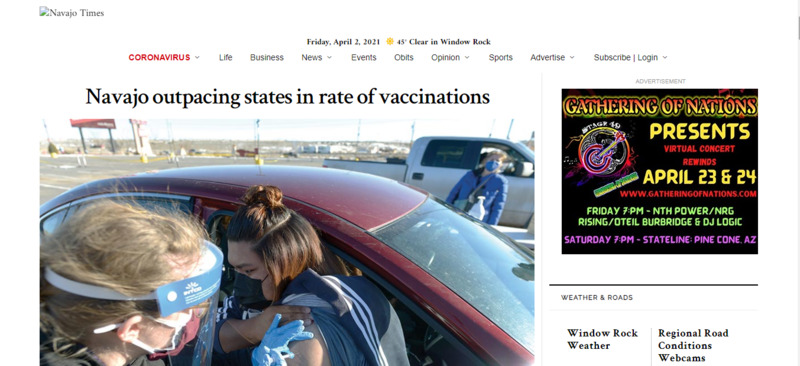 2021-03-09
2021-03-09Navajo Nation outpacing states in rate of vaccinations
By Rima Krisst | Mar 9, 2021 | CORONAVIRUS, News | WINDOW ROCK President Jonathan Nez proudly said last week that the Navajo Nation had exceeded its goal of administering 100,000 COVID-19 vaccine shots by end of February, crediting tireless health care workers who have been serving seven days a week to plan vaccinations and administer the vaccines. On Tuesday, the president’s office reported that 135,161 COVID-19 vaccine shots have gone into arms on the Navajo Nation, which represents 92% of the total 146,980 doses received and includes 48,800 persons who have had their second shots. This means that over 26% of the approximately 327,000 enrolled Navajos have gotten a shot through the Navajo Area Indian Health Service and tribal health care system, which is an amazing feat. By comparison, in New Mexico 22.4% of the population (738,705) has been given at least one shot. Arizona has administered at least one shot to 17.1% of the population (1,847,750), with Utah trailing behind at 12.2% receiving at least one shot (687,925), according to the CDC data vaccine tracker. And as of March 2, 15.3% of the U.S. population had received at least one shot, with 76.9 million shots administered, including 25.4 million receiving the second dose. Approximately 1.8 million vaccines per day are being administered daily in the U.S. So, percentage-wise, Navajo is outpacing both neighboring states and the general U.S. population. ‘Amazing partnership’ On a Feb. 25 IHS media call, IHS Chief Medical Officer Rear Adm. Michael Toedt reported that as of Feb. 18 the IHS had also achieved its goal of administering 400,000 doses of COVID-19 vaccine “across IHS, tribal, and urban Indian Health programs,” representing 16% of the “target population,” with 6.3% receiving two doses. “This milestone was reached ahead of schedule despite severe weather, making travel to health facilities difficult across much of Indian Country and leading to shipping delays,” said Toedt. Toedt said most IHS facilities have now vaccinated the majority of their priority populations and are moving into Phase 2, which includes those who work in higher risk settings such as schools and prisons. “Very shortly we expect that everyone who needs a vaccine will be able to receive it,” he said. Toedt credited IHS and tribal health care employees across the country who are committed to ensuring the protection of tribal communities in 11 geographic areas covering 26 states and 349 health facilities, many in rural and remote locations. “We have had an amazing partnership with our tribes to use all available resources to help with delivery of vaccine,” said Toedt. This included distribution and redistribution of vaccines by ground and air transportation as needed. Toedt said the IHS has also conducted over 2 million COVID-19 tests at a higher per capita than most states and is reporting a seven-day average test positivity rate of 4.5%, below the 5.6% all-races rate in the U.S., despite the fact that COVID-19 has had a disproportionate impact on American Indians/Alaska Natives. The Navajo Nation has conducted 245,085 COVID-19 tests resulting in 29,774 positive cases. ‘Developing trust’ Coordinated public relations campaigns in partnership with tribes have been key to the success of the vaccine rollout, said Toedt. Navajo Area IHS Chief Medical Officer Loretta Christensen agreed, saying public messaging has been critical. “This collaboration is one of the reasons we’ve been extremely successful,” said Christensen. “Honesty and transparency, developing that trust with the people you are serving is vital. We have spent a great deal of time on that relationship with our Navajo people to encourage them to be vaccinated.” She said the communication process has been very unified across Navajo and with the president’s office, using social media, radio, and a bilingual approach. “This is constant public education,” she said. “We encourage people in a very personal way that we would like them to be safe, keep their families, their communities safe. We feel very fortunate and grateful that our population has really stepped up.” Toedt acknowledged there has been some vaccine hesitancy relating to how quickly the vaccines were developed and whether or not they are completely safe, which has made some people distrustful. According to IHS Public Affairs Specialist Joshua Barnett, a recent IHS-funded survey by the Urban Indian Health Institute reported that 75% of Native Americans were willing to get a vaccine and 74% believe that doing so is their responsibility to help protect their community. “I’m confident that the process for vaccine development has the full integrity and completeness of time necessary to make sure these vaccines are safe, but it’s our job as healthcare providers to communicate that in a way that’s acceptable and trusted by our population,’ said Toedt. “We know our efforts are working and we’re seeing good delivery and acceptance of these vaccines in our communities.” Reaching the homebound Christensen said one of the strongest assets in the Navajo vaccination campaign has been the collaboration between public health nurses and community health representatives in reaching out to community members at the local level, including homebound elders and persons with disabilities. “These are the people out in the rural areas that know the families, that know the homes,” said Christensen. “We rely on them for that person-to-person contact out in the communities.” She said between 4,000 to 5,000 homebound individuals have actually been vaccinated at home or close to home. Moving forward with the goal of getting the Navajo population vaccinated and achieving “community immunity,” Navajo Area IHS wants to make sure that all 27,000 square miles of the Nation have been penetrated, said Christensen. “We want to be able to target any communities, populations or subgroups that have perhaps maybe not been able to get vaccinations,” she said. “So, our first step is to heat-map our whole area and then focus on those populations that are perhaps more rural or don’t have easy access to healthcare facilities.” “Our goal is to get every single person vaccinated and to keep our populations in Arizona, New Mexico and Utah safe,” she said. Christensen said her team will be working with chapters to identify anyone who might have been missed. They have also reached out to Navajos living off reservation and have established an online registry to help people find a place to get their vaccination. “We highly encourage them to come back if they need to and we will certainly take care of them and their families,” she said. Tracking variants In regard to surveillance for COVID-19 variants, Toedt said IHS does contribute its tests to state public health labs as well as different large lab corporations such as TriCore, LabCorp. and additional processes for genomic testing are in development. “The samples that are included through those mechanisms are sampled through the CDC’s processes to test for genomics,” said Toedt. Christensen said similarly the Navajo Area and the Health Command Center are working to establish more specific genomic surveillance within Navajo Nation. “In the meantime, we are participating in testing both in New Mexico and Arizona,” said Christensen. Christensen said the Navajo Epidemiology Center has also reached out to bordering states requesting any relevant information on variants be shared. “We all stand by ready to support this process and we are hopeful that we will have more specific information for Navajo Nation very soon,” she said. Christensen confirmed that she was not aware of any variants having been identified on the Navajo Nation from random sampling. “We have requested that information but we have not received it as of yet,” she said. Adverse events Any adverse events, or serious side effects, related to vaccinations within IHS are collected and reported to the same CDC system that collects the data nationally, said Toedt, but the data broken down by individual tribes is not publicly available. “We are part of that Vaccine Adverse Event Reporting System through the CDC,” said Toedt. “All adverse drug reactions are investigated by the CDC to determine what category it goes in and how they analyze data.” Navajo Area is gathering information on any adverse events on the Navajo Nation, but there are patient privacy issues when it comes to sharing that publicly, said Christensen. “We do, as (health care) institutions across Navajo Nation, share basic data with each other when we’re doing best practices,” she said. Christensen would not answer whether or not there had been any adverse events on the Nation. “I will say we have done very well with these vaccines,” she said. “There are certainly side effects which have been well defined, but we’ve had minimal significant adverse events. I cannot quantify that for you, but we are tracking those events across Navajo Nation.” Preventing transmission As far as keeping everyone safe after being vaccinated, Toedt said it’s still important to continue to wash your hands, stay six feet apart and to wear a mask. This is because vaccinated persons can theoretically still contract COVID-19 and spread it after being vaccinated, although they may not have any symptoms due to protection from the vaccine. There are also still many unknowns related to COVID-19 variants and to what extent they may evade vaccine protection, be more transmissible, or cause more serious disease. “We have been trying to report on possible variants most recently, explaining that we don’t have all the information yet on what the long term effects of those variants are,” said Christensen. “So we highly suggest that you still watch your distance, wash your hands and wear your mask.” Christensen said public messaging encouraging everyone to abide by the public health protocols in place, regardless of vaccination status, will continue until there is community immunity. -
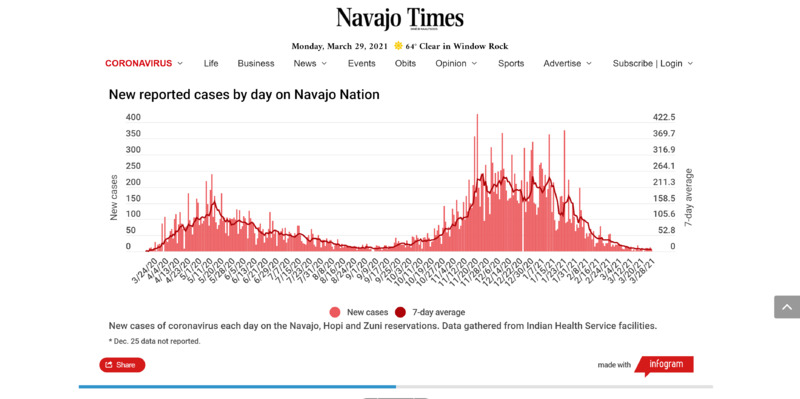 2021-03-29
2021-03-29In numbers: Tracking COVID-19 Across the Navajo Nation
In numbers: Tracking COVID-19 Across the Navajo Nation By Navajo Times | Mar 29, 2021 | CORONAVIRUS | On Sunday, Navajo Nation health officials reported 7 new COVID-19 cases. A total of 30,059 people have been sickened by the coronavirus. The rate of decrease in new cases is slowing. Nevertheless, the seven day average is 7 new cases per day, a decrease of 30 percent from the average two weeks earlier. On a per-capita basis, about 3 cases for every 100,000 people on the Navajo Nation are active. This means the Navajo Nation has the lowest per-capita cases anywhere in the 50 U.S. states. No new deaths were announced, leaving the total at 1,246 casualties of the virus. At least 16,342 people on the Navajo Nation have recovered. More than 8 of 10 people on the Navajo Nation have received at least one dose of the vaccine, or 86.3 percent of the population as of March 26, according to the Navajo Area Indian Health Service. A spokesperson for the Navajo Area IHS says 244,209 people get health care from it. Of those, 196,902 have received at least their first dose of a COVID-19 vaccine. That number includes 88,891 people, or 36.4 percent, who are fully vaccinated, according to the spokesperson. Caution is still warranted: Highly contagious variants of the virus continue to spread. The more lethal U.K. variant is doubling every 10 days throughout the United States. It now represents more than half of new U.S. cases. Many jurisdictions near the Navajo Nation are relaxing COVID restrictions. Some health experts warn that easing up right now is too soon. It could lead to an increase in new cases. Health experts recommend continued vigilance in wearing masks, social distancing, avoiding socializing with people outside your immediate household, and hand-washing. Double-masking also is recommended. For those who are fully vaccinated, the CDC still recommends wearing a mask and hand-washing; although social restrictions are more relaxed. Follow this link for complete CDC guidance for those who are vaccinated: https://www.cdc.gov/coronavirus/2019-ncov/vaccines/fully-vaccinated.html Although the Navajo Nation has relaxed some restrictions, a daily curfew remains in efffect from 10 p.m. to 5 a.m. Businesses may remain open until 9 p.m. timeline Positive Test Rate The estimated percentage of people who tested positive was 1.2 percent on Sunday. The 7-day average positive test rate was estimated at 1.9 percent. The World Health Organization recommends a 7-day average positive test rate of less than 10 percent for two weeks in a row. Localities that have a test rate of 3 percent or less are most successful in containing COVID-19, according to the WHO. At Hopi, one new cases was reported overnight, bringing the total to 1,376. The Hopi radio station reported on its Facebook page that at least 120 people have died since the pandemic began last year, but the Hopi Tribe has not consistently reported fatalities from the virus. The following charts and maps show the extent and location of the coronavirus on and near the Navajo Nation. Hover over, tap or click the map markers and graph for expanded information. (Last updated March 29, 2021 at 10:44 a.m. MDT.) Growth of COVID-19 on Navajo Nation and Hopi Reservation Cases April 2020 June 2020 August 2020 October 2020 December 2020 February 2021 0 10,000 20,000 30,000 40,000 Number Date Cases Mar 16, 2020 2 Mar 18, 2020 3 Mar 20, 2020 14 Mar 21, 2020 26 Mar 23, 2020 29 Mar 24, 2020 39 Mar 25, 2020 69 Mar 26, 2020 71 Mar 27, 2020 92 Mar 28, 2020 115 Mar 29, 2020 128 Apr 1, 2020 214 Apr 2, 2020 214 Apr 4, 2020 321 Apr 5, 2020 354 Apr 6, 2020 384 Apr 7, 2020 426 Apr 8, 2020 488 Apr 9, 2020 558 Apr 10, 2020 597 Apr 11, 2020 698 Apr 13, 2020 813 Apr 14, 2020 838 Apr 15, 2020 921 Apr 16, 2020 1,042 Apr 17, 2020 1,127 Apr 18, 2020 1,197 Apr 20, 2020 1,206 Apr 22, 2020 1,282 Apr 23, 2020 1,360 Apr 24, 2020 1,540 Apr 25, 2020 1,637 Apr 26, 2020 1,716 Apr 27, 2020 1,769 Apr 28, 2020 1,873 Apr 29, 2020 1,977 Apr 30, 2020 2,141 May 1, 2020 2,292 May 2, 2020 2,373 May 4, 2020 2,474 May 5, 2020 2,559 May 6, 2020 2,654 May 7, 2020 2,757 May 9, 2020 2,976 May 10, 2020 3,122 May 11, 2020 3,202 May 13, 2020 3,392 May 14, 2020 3,632 May 15, 2020 3,740 May 16, 2020 3,912 May 17, 2020 4,002 May 18, 2020 4,071 May 19, 2020 4,153 May 20, 2020 4,253 May 21, 2020 4,434 May 22, 2020 4,529 May 23, 2020 4,633 May 24, 2020 4,689 May 25, 2020 4,794 May 26, 2020 4,842 May 27, 2020 4,944 May 28, 2020 5,044 May 29, 2020 5,145 May 30, 2020 5,250 May 31, 2020 5,348 Jun 1, 2020 5,479 Jun 2, 2020 5,533 Jun 3, 2020 5,661 Jun 4, 2020 5,730 Jun 5, 2020 5,808 Jun 6, 2020 5,918 Jun 7, 2020 6,020 Jun 8, 2020 6,110 Jun 9, 2020 6,150 Jun 10, 2020 6,275 Jun 11, 2020 6,378 Jun 12, 2020 6,470 Jun 13, 2020 6,554 Jun 14, 2020 6,611 Jun 15, 2020 6,633 Jun 16, 2020 6,672 Jun 17, 2020 6,747 Jun 18, 2020 6,832 Jun 19, 2020 6,894 Jun 20, 2020 6,963 Jun 21, 2020 6,990 Jun 22, 2020 7,045 Jun 23, 2020 7,088 Jun 24, 2020 7,157 Jun 25, 2020 7,278 Jun 26, 2020 7,320 Jun 27, 2020 7,414 Jun 28, 2020 7,469 Jun 29, 2020 7,532 Jun 30, 2020 7,549 Jul 1, 2020 7,613 Jul 2, 2020 7,669 Jul 3, 2020 7,733 Jul 4, 2020 7,804 Jul 5, 2020 7,840 Jul 6, 2020 7,914 Jul 7, 2020 7,941 Jul 8, 2020 7,981 Jul 9, 2020 8,042 Jul 10, 2020 8,098 Jul 11, 2020 8,124 Jul 12, 2020 8,187 Jul 13, 2020 8,243 Jul 14, 2020 8,290 Jul 15, 2020 8,370 Jul 16, 2020 8,486 Jul 17, 2020 8,536 Jul 18, 2020 8,568 Jul 19, 2020 8,593 Jul 20, 2020 8,617 Jul 21, 2020 8,639 Jul 22, 2020 8,684 Jul 23, 2020 8,734 Jul 24, 2020 8,768 Jul 25, 2020 8,837 Jul 26, 2020 8,891 Jul 27, 2020 8,912 Jul 28, 2020 8,927 Jul 29, 2020 8,968 Jul 30, 2020 9,019 Jul 31, 2020 9,055 Aug 1, 2020 9,068 Aug 2, 2020 9,103 Aug 3, 2020 9,139 Aug 4, 2020 9,156 Aug 5, 2020 9,195 Aug 6, 2020 9,223 Aug 7, 2020 9,257 Aug 8, 2020 9,293 Aug 9, 2020 9,308 Aug 10, 2020 9,315 Aug 11, 2020 9,334 Aug 12, 2020 9,356 Aug 13, 2020 9,394 Aug 14, 2020 9,412 Aug 15, 2020 9,423 Aug 16, 2020 9,447 Aug 17, 2020 9,469 Aug 18, 2020 9,486 Aug 19, 2020 9,500 Aug 20, 2020 9,519 Aug 21, 2020 9,531 Aug 22, 2020 9,545 Aug 23, 2020 9,547 Aug 24, 2020 9,557 Aug 25, 2020 9,573 Aug 26, 2020 9,597 Aug 27, 2020 9,601 Aug 28, 2020 9,780 Aug 29, 2020 9,789 Aug 30, 2020 9,800 Aug 31, 2020 9,820 Sep 1, 2020 9,830 Sep 2, 2020 9,847 Sep 3, 2020 9,871 Sep 4, 2020 9,883 Sep 5, 2020 9,891 Sep 6, 2020 9,900 Sep 7, 2020 9,901 Sep 8, 2020 9,903 Sep 9, 2020 9,915 Sep 10, 2020 9,933 Sep 11, 2020 9,952 Sep 12, 2020 9,969 Sep 13, 2020 9,977 Sep 14, 2020 9,982 Sep 15, 2020 9,992 Sep 16, 2020 10,059 Sep 17, 2020 10,083 Sep 18, 2020 10,090 Sep 19, 2020 10,107 Sep 20, 2020 10,119 Sep 21, 2020 10,131 Sep 22, 2020 10,141 Sep 23, 2020 10,167 Sep 24, 2020 10,212 Sep 25, 2020 10,237 Sep 26, 2020 10,269 Sep 27, 2020 10,290 Sep 28, 2020 10,312 Sep 29, 2020 10,333 Sep 30, 2020 10,355 Oct 1, 2020 10,369 Oct 2, 2020 10,404 Oct 3, 2020 10,421 Oct 4, 2020 10,441 Oct 5, 2020 10,454 Oct 6, 2020 10,501 Oct 7, 2020 10,546 Oct 8, 2020 10,582 Oct 9, 2020 10,632 Oct 10, 2020 10,675 Oct 11, 2020 10,696 Oct 12, 2020 10,728 Oct 13, 2020 10,737 Oct 14, 2020 10,780 Oct 15, 2020 10,819 Oct 16, 2020 10,857 Oct 17, 2020 10,913 Oct 18, 2020 10,955 Oct 19, 2020 10,969 Oct 20, 2020 10,999 Oct 21, 2020 11,030 Oct 22, 2020 11,101 Oct 23, 2020 11,151 Oct 24, 2020 11,217 Oct 25, 2020 11,298 Oct 26, 2020 11,362 Oct 27, 2020 11,386 Oct 28, 2020 11,462 Oct 29, 2020 11,603 Oct 30, 2020 11,694 Oct 31, 2020 11,753 Nov 1, 2020 11,828 Nov 2, 2020 11,875 Nov 3, 2020 11,947 Nov 4, 2020 12,080 Nov 5, 2020 12,195 Nov 6, 2020 12,288 Nov 7, 2020 12,447 Nov 8, 2020 12,571 Nov 9, 2020 12,641 Nov 10, 2020 12,720 Nov 11, 2020 12,818 Nov 12, 2020 12,971 Nov 13, 2020 13,069 Nov 14, 2020 13,249 Nov 15, 2020 13,373 Nov 16, 2020 13,596 Nov 17, 2020 13,744 Nov 18, 2020 13,880 Nov 19, 2020 14,085 Nov 20, 2020 14,441 Nov 21, 2020 14,612 Nov 22, 2020 15,039 Nov 23, 2020 15,236 Nov 24, 2020 15,374 Nov 25, 2020 15,616 Nov 26, 2020 15,862 Nov 27, 2020 15,954 Nov 28, 2020 16,223 Nov 29, 2020 16,427 Nov 30, 2020 16,595 Dec 1, 2020 16,711 Dec 2, 2020 17,035 Dec 3, 2020 17,310 Dec 4, 2020 17,495 Dec 5, 2020 17,738 Dec 6, 2020 17,915 Dec 7, 2020 18,163 Dec 8, 2020 18,324 Dec 9, 2020 18,575 Dec 10, 2020 18,943 Dec 11, 2020 19,199 Dec 12, 2020 19,420 Dec 13, 2020 19,608 Dec 14, 2020 19,766 Dec 15, 2020 19,929 Dec 16, 2020 20,095 Dec 17, 2020 20,395 Dec 18, 2020 20,569 Dec 19, 2020 20,810 Dec 20, 2020 21,019 Dec 21, 2020 21,177 Dec 22, 2020 21,327 Dec 23, 2020 21,513 Dec 24, 2020 21,833 Dec 25, 2020 21,833 Dec 26, 2020 22,155 Dec 27, 2020 22,155 Dec 28, 2020 22,371 Dec 29, 2020 22,526 Dec 30, 2020 22,776 Dec 31, 2020 23,090 Jan 1, 2021 23,429 Jan 2, 2021 23,581 Jan 3, 2021 23,728 Jan 4, 2021 23,841 Jan 5, 2021 23,978 Jan 6, 2021 24,247 Jan 7, 2021 24,521 Jan 8, 2021 24,776 Jan 9, 2021 24,979 Jan 10, 2021 25,216 Jan 11, 2021 25,383 Jan 12, 2021 25,383 Jan 13, 2021 25,746 Jan 14, 2021 25,952 Jan 15, 2021 26,073 Jan 16, 2021 26,287 Jan 17, 2021 26,383 Jan 18, 2021 26,448 Jan 19, 2021 26,517 Jan 20, 2021 26,612 Jan 21, 2021 26,782 Jan 22, 2021 26,955 Jan 23, 2021 27,109 Jan 24, 2021 27,484 Jan 25, 2021 27,573 Jan 26, 2021 27,665 Jan 27, 2021 27,887 Jan 28, 2021 27,987 Jan 29, 2021 28,075 Jan 30, 2021 28,217 Jan 31, 2021 28,325 Feb 1, 2021 28,388 Feb 2, 2021 28,471 Feb 3, 2021 28,544 Feb 4, 2021 28,668 Feb 5, 2021 28,796 Feb 6, 2021 28,872 Feb 7, 2021 28,897 Feb 8, 2021 28,937 Feb 9, 2021 28,994 Feb 10, 2021 29,041 Feb 11, 2021 29,098 Feb 12, 2021 29,167 Feb 13, 2021 29,205 Feb 14, 2021 29,269 Feb 15, 2021 29,283 Feb 16, 2021 29,308 Feb 17, 2021 29,336 Feb 18, 2021 29,386 Feb 19, 2021 29,464 Feb 20, 2021 29,509 Feb 21, 2021 29,535 Feb 22, 2021 29,551 Feb 23, 2021 29,576 Feb 24, 2021 29,602 Feb 25, 2021 29,655 Feb 26, 2021 29,710 Feb 27, 2021 29,719 Feb 28, 2021 29,740 Mar 1, 2021 29,754 Mar 2, 2021 29,774 Mar 3, 2021 29,794 Mar 4, 2021 29,816 Mar 5, 2021 29,838 Mar 6, 2021 29,857 Mar 7, 2021 29,866 Mar 8, 2021 29,873 Mar 9, 2021 29,887 Mar 10, 2021 29,900 Mar 11, 2021 29,911 Mar 12, 2021 29,930 Mar 13, 2021 29,945 Mar 14, 2021 29,948 Mar 15, 2021 29,954 Mar 16, 2021 29,957 Mar 17, 2021 29,968 Mar 18, 2021 29,987 Mar 19, 2021 29,992 Mar 20, 2021 29,998 Mar 21, 2021 30,007 Mar 22, 2021 30,007 Mar 23, 2021 30,010 Print COVID-19 Cases on the Navajo Reservation Presumptive Positive Tested Positive Died Recovered 0 5000 10000 15000 20000 25000 30000 Navajo Nation Chinle AZ IHS Tuba City Regional Health Care Shiprock NM IHS Gallup NM IHS Fort Defiance NM IHS Crownpoint NM IHS Kayenta AZ IHS Winslow IHS Zuni reservation Hopi reservation Utah Navajo Health System Number of cases Community Presumptive Positive Tested Positive Died Recovered Navajo Nation 0 12483 1205 16,212 Chinle AZ IHS 5496 0 0 Tuba City Regional Health Care 6 5324 0 0 Shiprock NM IHS 0 5018 0 0 Gallup NM IHS 0 4729 0 0 Fort Defiance NM IHS 0 3562 0 0 Crownpoint NM IHS 0 2861 0 0 Kayenta AZ IHS 0 2642 0 0 Winslow IHS 0 1948 0 0 Zuni reservation 0 1454 0 0 Hopi reservation 0 1372 120 0 Utah Navajo Health System 0 1064 0 0 NOTE: Navajo Nation officials have been reconciling discrepancies for July and August data. At the end of August, in a press release, the president’s office added 165 cases that occurred between April 6 and Aug. 12. Then, on Sept. 8, they added 2 more cases for July. Health officials also added 16 more deaths to the overall tally at the beginning of September. According to a news release, the deaths occurred between May and August. Officials blamed several states for delayed results. On Sept. 16, officials added 49 previously unreported cases in New Mexico. -
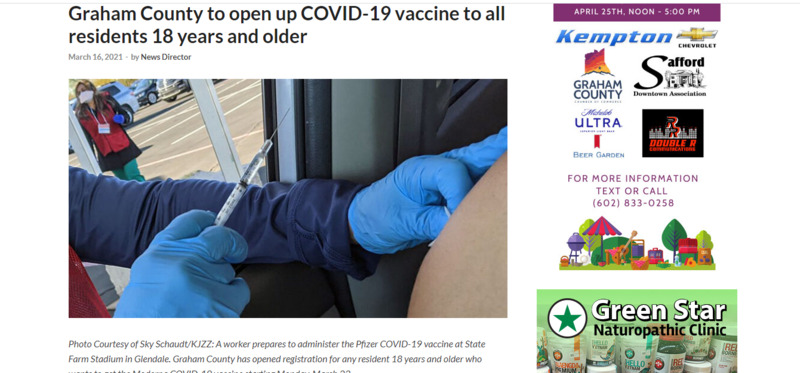 2021-03-16
2021-03-16Graham County (AZ) to open up COVID-19 vaccine to all residents 18 years and older
Staff Reports SAFFORD – The Graham County Department of Health and Human Services has announced that starting Monday, March 22, any resident of Graham County who is 18 years old or older will be eligible to receive a vaccine for COVID-19. Those who would like a COVID-19 vaccination should contact their primary care physician or schedule an appointment with the health department by clicking here. Those who schedule appointments will currently be given the two-shot Moderna vaccine at the Graham County Health Department Vaccination Center at 627 W. Main Street in Downtown Safford. The health department will announce a clinic for the one-shot Johnson and Johnson vaccine at a later date. While the Pfizer and Moderna two-shot vaccines utilize messenger RNA, the Johnson & Johnson vaccine works through a different mechanism and uses the more traditional DNA, which is introduced to the nucleus of cells with an adenovirus which is modified so it cannot replicate itself and cause disease. All three vaccines have been approved for use by the federal government and have safety records in good standing. All prompt the body to produce T-cells, which retain a memory of the protein and attack it. “We would like to thank everyone for their support as we have navigated through the COVID-19 pandemic this past year,” said Graham County Health Department Director Brian Douglas. Greenlee County Gila Health Resources in Greenlee County will hold a COVID-19 vaccine drive at the Morenci Club Hall at 314 Plaza Dr. in Morenci on Friday, March 19, from 1 – 8 p.m. At the vaccine drive, any adult resident of Greenlee County or those who work in Greenlee County can show up to receive a dose of the Moderna vaccine with no appointment or registration necessary. -
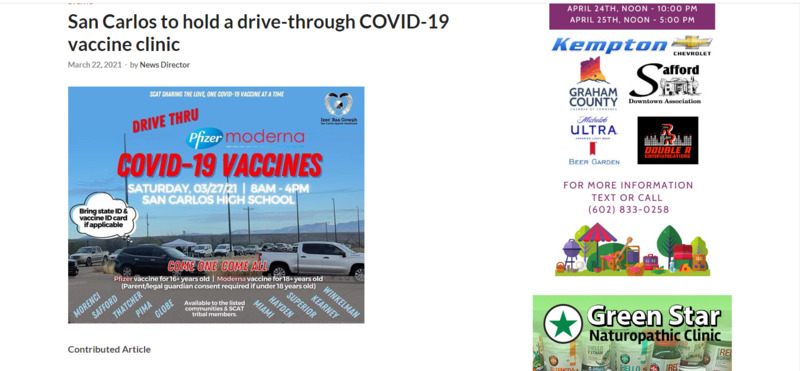 2021-03-21
2021-03-21San Carlos (AZ) to hold a drive-through COVID-19 vaccine clini6c
March 22, 2021 - by News Director Contributed Article SAN CARLOS – The San Carlos Apache Healthcare Corporation is proud to present a COVID-19 vaccine drive-through clinic for SCAT members and their family and friends of the surrounding communities of Globe, Miami, Superior, Hayden, Winkleman, Kearny, Pima, Thatcher, Safford, and Morenci. Our SCAHC Vaccination team will be administering the Pfizer and Moderna vaccine at the San Carlos High School, on Saturday, March 27, from 8 a.m. – 4 p.m. No appointment is necessary. For the Pfizer vaccine, those receiving it must be 16 years of age or older (must have a parent/legal guardian consent if under 18) For the Moderna vaccine, those receiving it must be 18 years of age or older. Please remember to bring your state ID. There is no charge for the vaccine.
